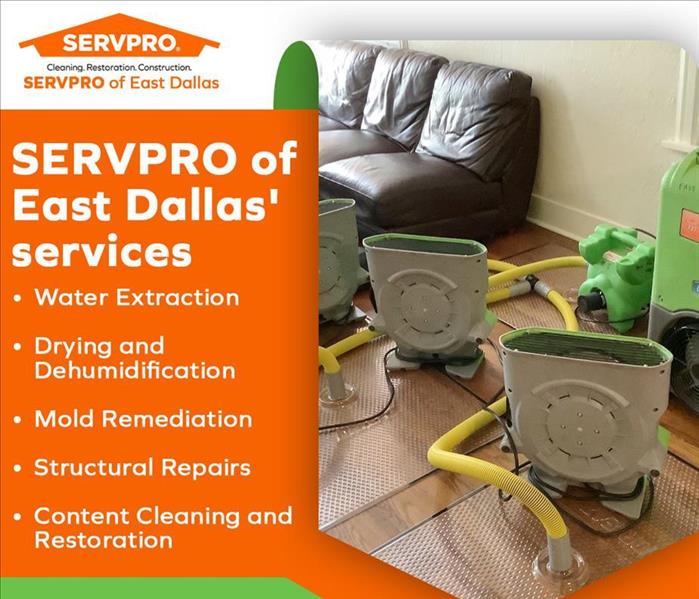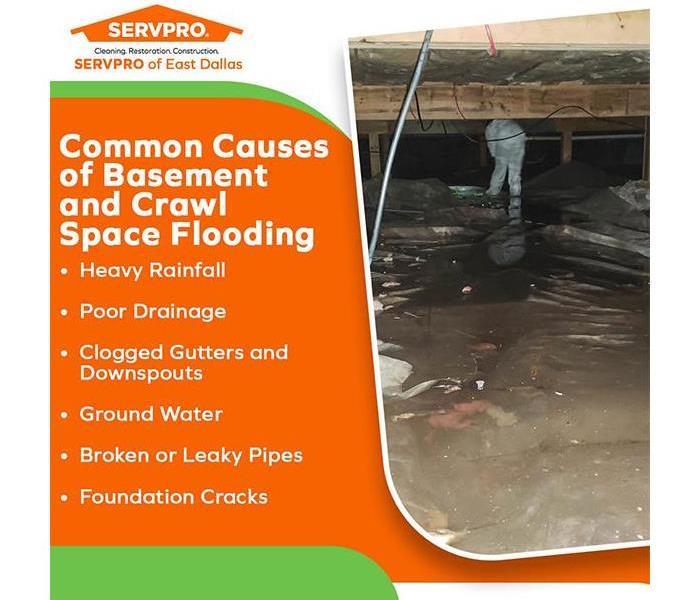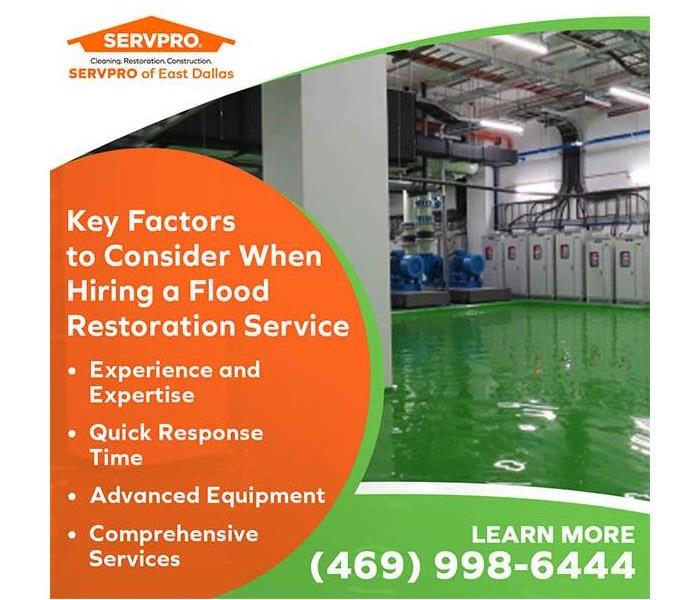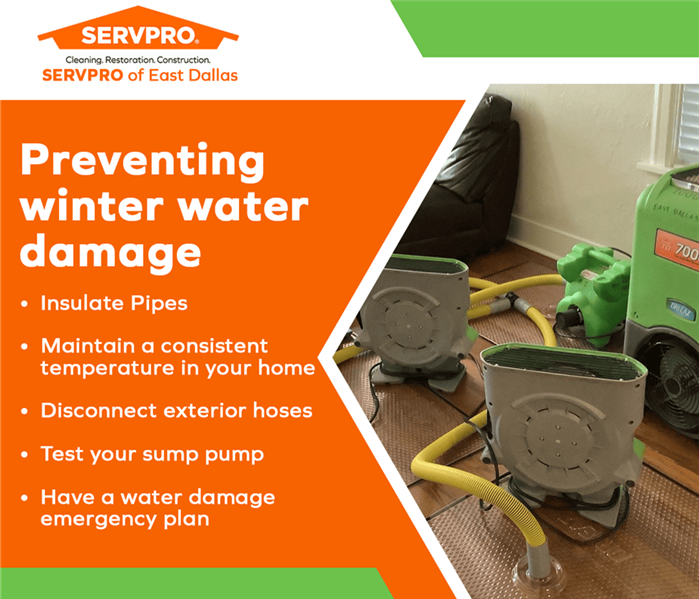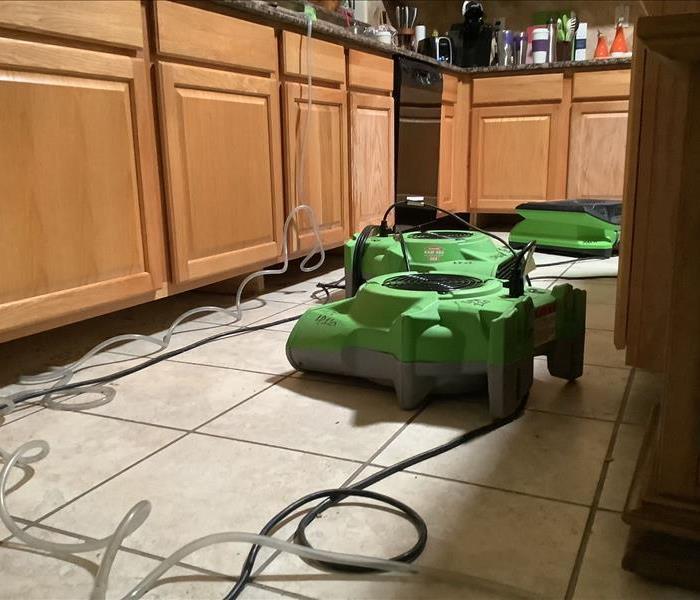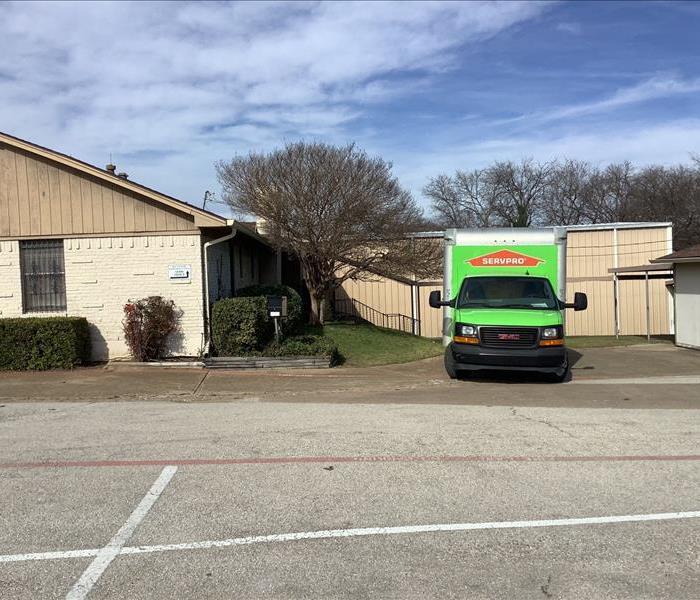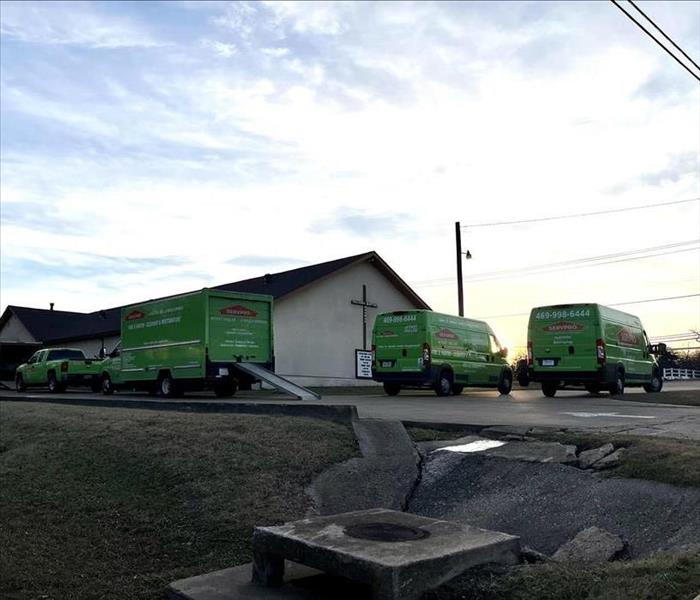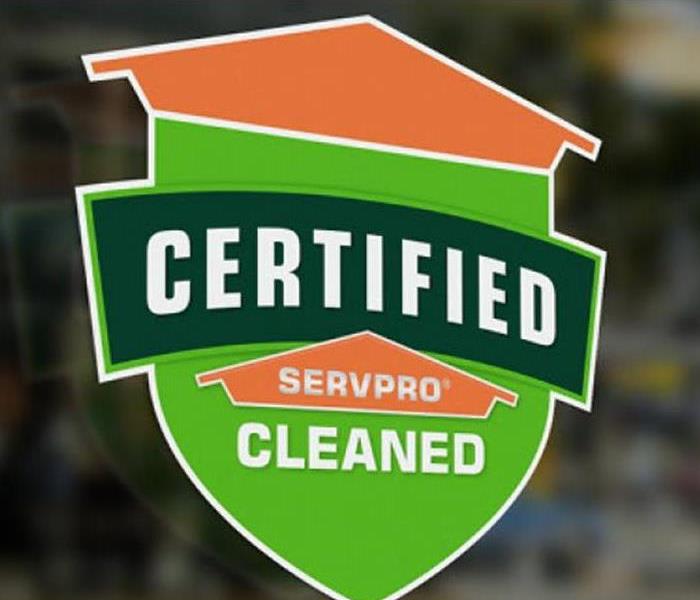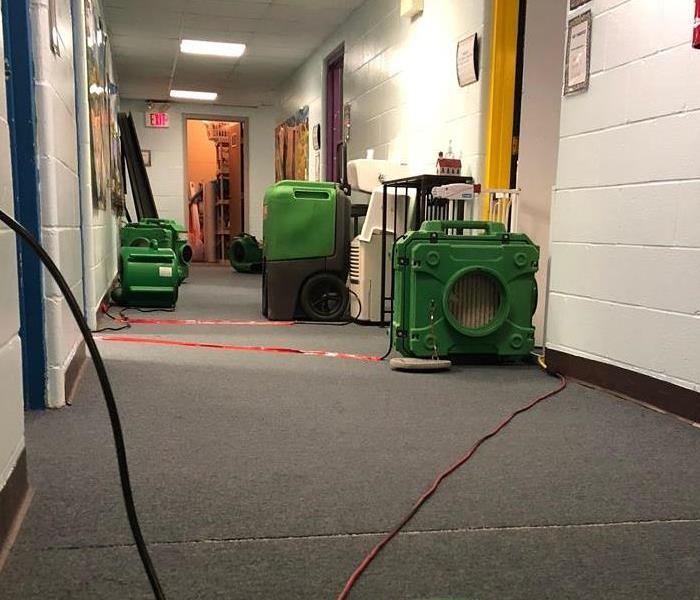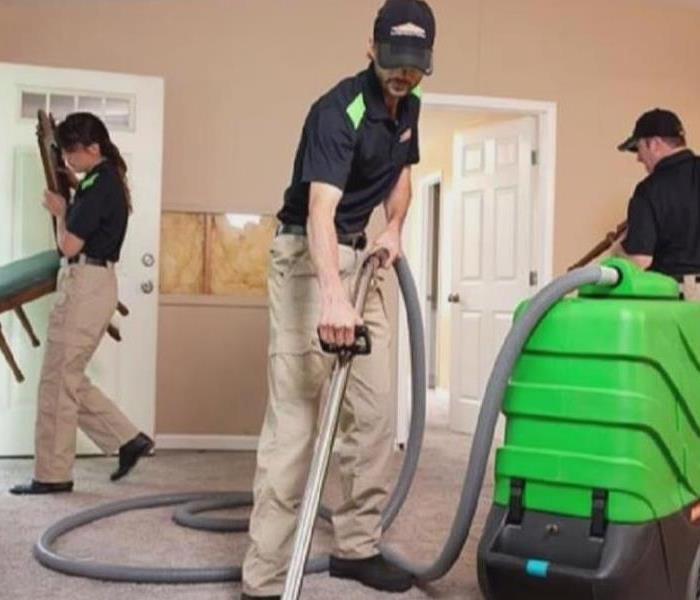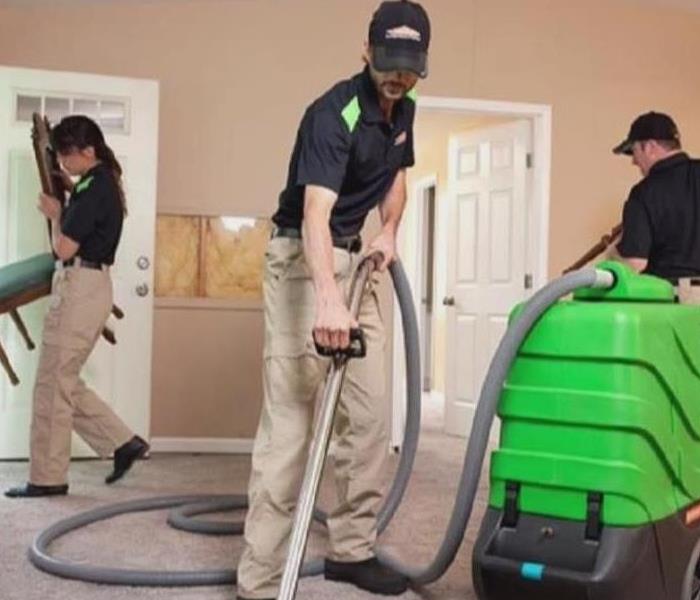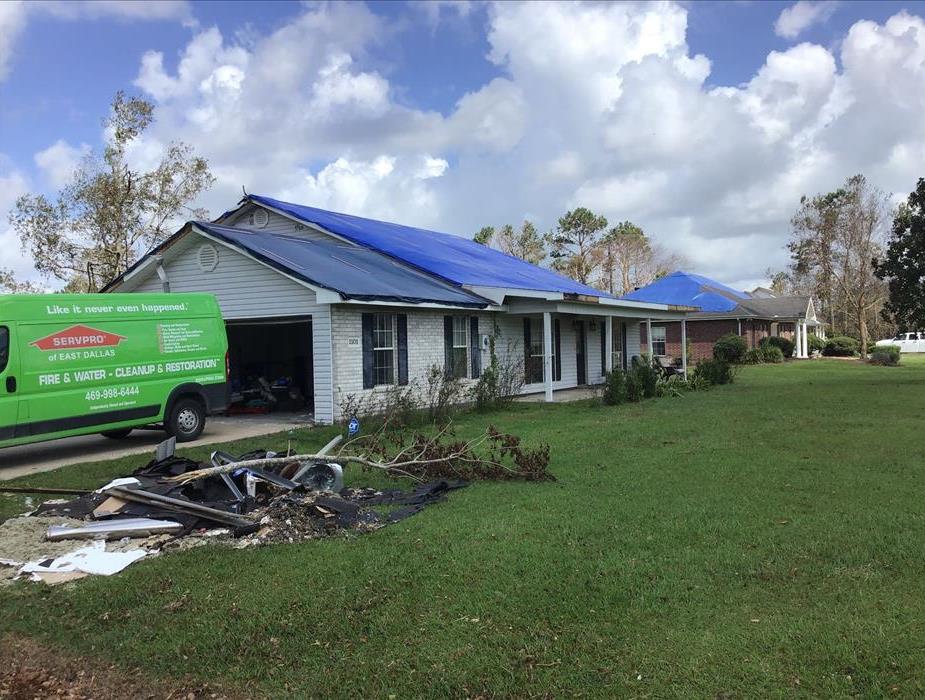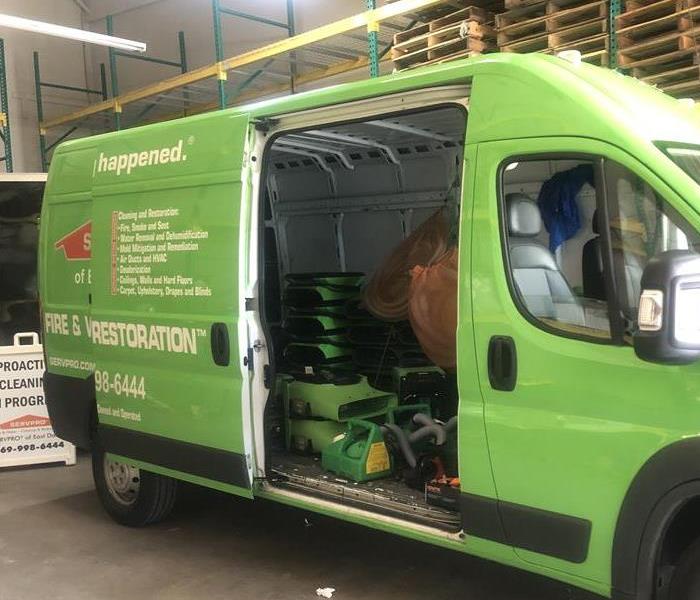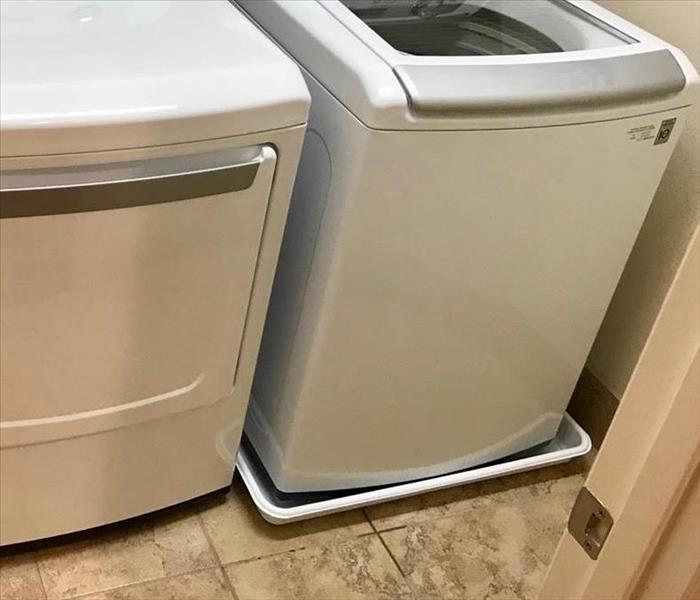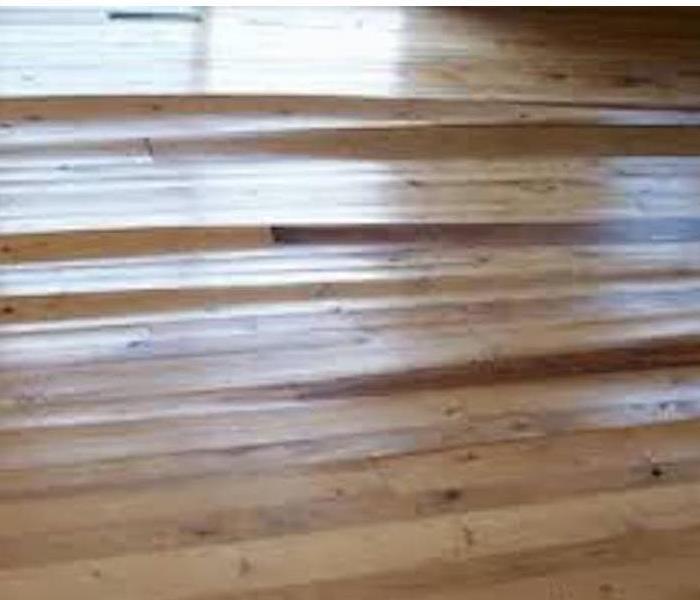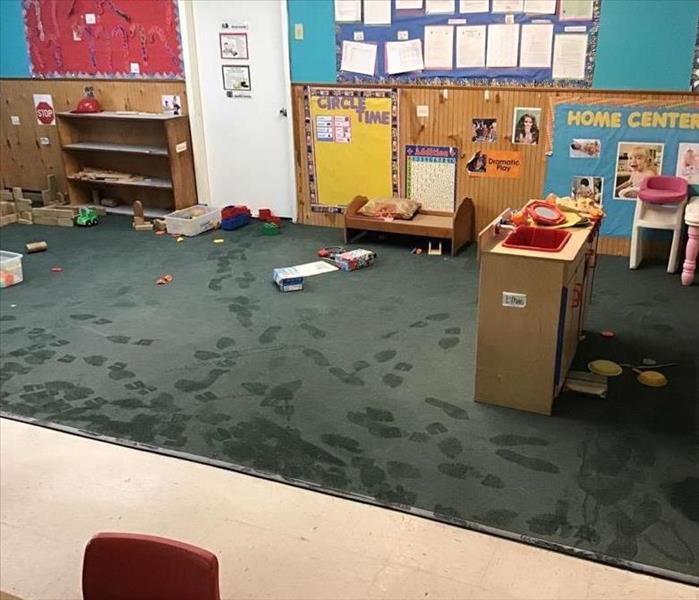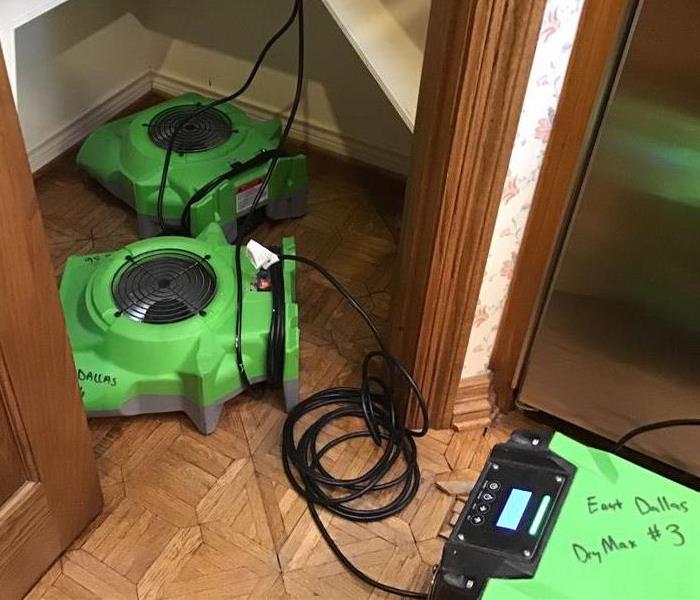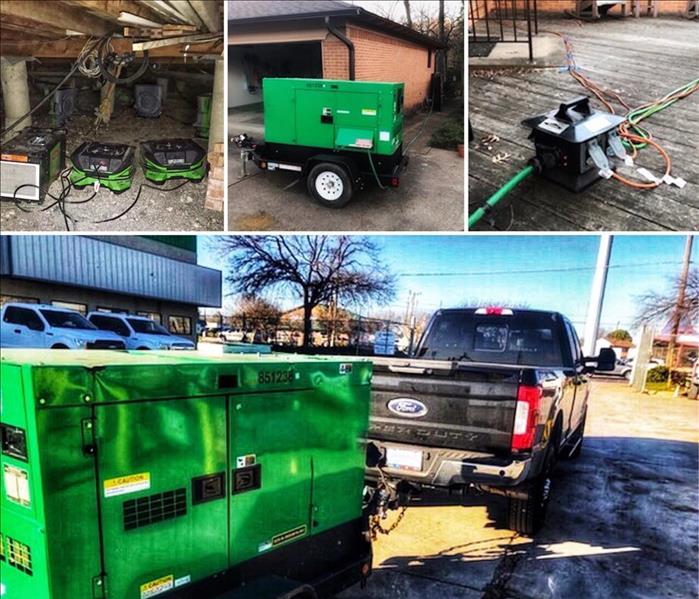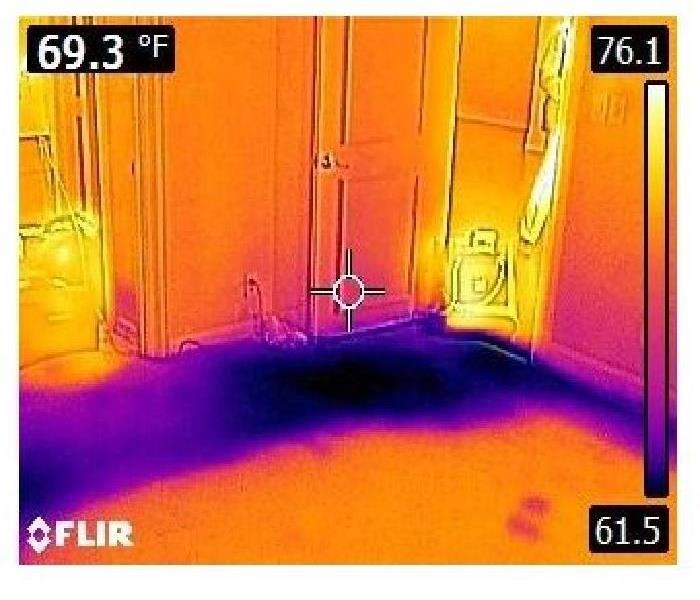Recent Water Damage Posts
Water Damage Restoration in Forest Hills: How it Impacts Homes & Appliances
2/13/2025 (Permalink)
Water damage can be a serious issue for any homeowner, but Forest Hills residents face unique challenges that increase their risk. From the dangers of flooding and heavy rainfall to aging plumbing in older homes, the need for water damage restoration and water removal services is a reality for many. Fortunately, SERVPRO of East Dallas provides expert flood cleanup and a range of restoration services to help homeowners recover quickly from these unfortunate events. The combination of mature trees, established neighborhoods with older homes, and the area's specific weather patterns create a perfect storm for potential water damage.
Why Forest Hills Homes Are Particularly Vulnerable to Water Damage
Many homes in Forest Hills boast beautiful, mature trees. While these trees enhance the neighborhood's charm, their extensive root systems can infiltrate aging sewer lines and cause blockages that lead to backups and flooding. Older homes, common in this area, may also have outdated plumbing systems that are more prone to leaks and corrosion.
The Costly Consequences of Ignoring Water Damage
Water damage isn't just an inconvenience; it's a serious threat to your home's structural integrity and your family's health. Even small leaks, if left unattended, can have serious consequences:
- Mold growth: Damp environments encourage mold spores to flourish, potentially causing respiratory issues and allergies.
- Structural damage: Water weakens wood, drywall, and even concrete, leading to costly repairs.
- Compromised electrical systems: Water and electricity are a dangerous mix, increasing the risk of short circuits and fires.
- Decreased property value: Unresolved water damage makes your home less attractive to potential buyers.
By understanding the causes of water damage and taking proactive steps to protect your home, you can avoid these costly consequences and maintain a safe and healthy living environment.
Common Causes of Water Damage in Forest Hills Homes
Water damage can creep into your Forest Hills home from various sources. Recognizing these common culprits is the first step toward effective prevention.
Plumbing Issues: Clogged Drains, Leaks, and Burst Pipes
The plumbing systems in older Forest Hills homes are frequently outdated, with pipes that are prone to corrosion and leakage. These leaks, which are frequently concealed beneath floors or inside walls, have the capacity to do significant harm before anyone notices. In their quest for water, tree roots may also choke and backup sewer pipes, causing wastewater to flood back into your house. To avoid these problems, preventive maintenance and routine plumbing inspections are essential.
Severe Weather Events: Snowmelt, Flooding, and Heavy Rainfall
Periods of heavy rainfall and periodic flash flooding occur in Forest Hills. Water intrusion and basement flooding may result from drainage systems being overloaded by heavy rainfall. If gutters and downspouts are clogged or damaged, snowmelt in the winter can potentially cause water damage.
Faulty Appliances: Washing Machines, Dishwashers, and Water Heaters
Water-related appliances are common sources of household leaks. A malfunctioning washing machine hose can burst, flooding your laundry room. Aging dishwashers can develop leaks, and water heaters can rupture, causing significant water damage. Regularly inspect appliance hoses and connections for signs of wear and tear.
Roof Leaks and Gutter Issues
The abundant trees in Forest Hills, while beautiful, can pose a threat to your roof. Falling branches and accumulated leaves can damage shingles and clog gutters. Clogged gutters prevent proper drainage, allowing water to pool and seep into your roof and walls. Regular roof and gutter maintenance, including cleaning and inspections, is essential.
Foundation Issues and Basement Seepage
Forest Hills homes with basements are vulnerable to water damage caused by foundation cracks and hydrostatic pressure. Heavy rains can saturate the soil around your foundation, forcing water through cracks and into your basement. Proper grading, waterproofing, and sump pump installation can help mitigate these risks.
The Devastating Impact of Water Damage on Electrical Appliances
Water and electricity are a dangerous combination. When water damage affects your Forest Hills home, your electrical appliances and systems are at serious risk.
Short Circuits and Electrical Fires
Water conducts electricity. When water comes into contact with live wires or electrical components, it can cause a short circuit. This sudden surge of electricity can generate intense heat, potentially igniting nearby flammable materials and leading to a devastating house fire.
Damage to Wiring and Electrical Components
Exposure to water can corrode wiring and damage sensitive electrical components within your appliances. This corrosion can lead to malfunctions, reduced efficiency, and even complete failure of the appliance.
Malfunction and Reduced Lifespan of Appliances
Water damage can affect a wide range of appliances in your home, compromising their functionality and shortening their lifespan:
- Refrigerators: Water can damage the electronic controls, compressor, and insulation, leading to cooling issues and food spoilage.
- HVAC Systems: Water can damage the electrical components of your furnace, air conditioner, or heat pump, affecting their ability to heat or cool your home effectively.
- Entertainment Systems: Water can ruin sensitive electronics in televisions, stereos, and gaming consoles, causing permanent damage.
The Dangers of Electrocution
The most immediate danger of water damage near electrical appliances is the risk of electrocution. If you come into contact with a water-damaged appliance or electrical outlet, you could receive a potentially fatal electric shock. It's vital to turn off the power to affected areas immediately and avoid contact with any electrical devices until they have been thoroughly inspected and dried by a qualified professional.
Specific Electrical Appliances at Risk in Water-Damaged Forest Hills Homes
Water damage doesn't discriminate. It can affect any electrical appliance in your Forest Hills home, from major appliances to everyday gadgets. Understanding the specific risks associated with each type of appliance can help you prioritize safety and take appropriate action.
Large Appliances: Refrigerators, Washing Machines, Dryers, Dishwashers, Ovens
- Refrigerators: Water can damage the electronic controls, compressor, and insulation, leading to cooling failures and food spoilage.
- Washing Machines: The electrical components that control the washing machine's cycles are vulnerable to water damage, potentially causing malfunctions or even starting fires.
- Dryers: Water can damage the heating element, motor, and control panel, creating a fire hazard.
- Dishwashers: Leaks can damage the electrical components that control the dishwasher's cycles and the heating element.
- Ovens: Water can damage the electronic controls, heating elements, and wiring, posing a serious fire risk.
HVAC Systems: Furnaces, Air Conditioners, and Heat Pumps
HVAC systems often have exposed electrical components and wiring. Water damage can lead to short circuits, blower motor failures, and control board malfunctions. This can disrupt your home's heating and cooling, leading to discomfort and potential health risks in extreme weather.
Entertainment Systems: TVs, Stereos, Gaming Consoles
These devices contain delicate electronic components that are highly susceptible to water damage. Exposure to water can cause short circuits, damage screens, and ruin speakers, rendering them unusable.
Small Appliances: Microwaves, Toasters, Coffee Makers
Even small appliances are not immune to the dangers of water damage. Water can damage the heating elements, controls, and wiring in these devices, creating a fire hazard or causing them to malfunction.
Recognizing the Signs of Water Damage in Your Forest Hills Home
Water damage isn't always obvious. It can be insidious, lurking behind walls, under floors, and in hidden corners of your Forest Hills home. Knowing how to spot the subtle signs is key to early detection and preventing extensive damage.
Visible Signs: Stains, Warping, Puddles, and Mold Growth
Keep a watchful eye out for these telltale visual indicators:
- Discoloration: Water stains on walls, ceilings, or floors can indicate a leak or past water damage. Look for yellowish-brown stains, especially in areas prone to moisture, like bathrooms and kitchens.
- Warping: Wood floors, baseboards, and cabinets can warp or buckle when exposed to moisture.
- Puddles: Obvious puddles or standing water are a clear sign of a problem. Investigate the source immediately.
- Mold Growth: Mold thrives in damp environments. Black, green, or white patches on walls, ceilings, or other surfaces could indicate a hidden moisture problem.
Auditory Clues: Dripping Sounds, Gurgling Pipes
Water damage can sometimes be audible before it becomes visible. Pay attention to these sounds:
- Dripping: A constant dripping sound, even if faint, could indicate a leak in your plumbing or roof.
- Gurgling: Strange gurgling sounds from your drains or pipes can signal a blockage or plumbing issue.
Olfactory Warnings: Musty Odors
Your nose can be a powerful tool in detecting water damage. Be alert for these smells:
Musty Odors: A persistent musty or damp smell in a particular room or area often indicates the presence of mold or mildew, a common consequence of hidden water damage.
By being vigilant and recognizing these signs, you can address water damage promptly and prevent it from becoming a major problem in your Forest Hills home. If you suspect water damage, don't hesitate to contact a professional restoration company like SERVPRO of East Dallas for a thorough inspection and expert advice.
Protecting Your Home and Appliances from Water Damage
Protecting your Forest Hills home from water damage requires a proactive approach. By taking preventive measures, you can safeguard your property, belongings, and peace of mind.
Regular Maintenance and Inspections: Plumbing, Roof, Appliances
Prevention is key. Schedule these routine checks:
- Plumbing: Have a licensed plumber inspect your plumbing system annually, paying close attention to pipes, fixtures, and connections. This includes checking for leaks, corrosion, and signs of tree root intrusion.
- Roof: Inspect your roof twice a year, especially after storms or heavy winds. Look for missing or damaged shingles and clear debris from gutters and downspouts.
- Appliances: Regularly inspect appliance hoses for cracks, bulges, or leaks. Replace hoses every few years as a preventive measure.
Proper Drainage and Grading Around Your Home
Ensure water flows away from your foundation:
- Grading: The ground around your home should slope away from the foundation to prevent water from pooling and seeping into your basement.
- Gutters and Downspouts: Make sure your gutters are clean and free of debris and that downspouts extend far enough away from your foundation to direct water away from your home.
Installing Sump Pumps and Backflow Preventers
Consider these extra layers of protection:
- Sump Pumps: If your home has a basement, a sump pump can help with flood cleanup and water removal around the foundation, preventing flooding.
- Backflow Preventers: These devices prevent sewage from backing up into your home through your drains during heavy rains or sewer line blockages.
Investing in Water Leak Detection Systems
Technology can be your ally:
- Water Leak Detectors: These sensors can detect even small leaks and send alerts to your smartphone, allowing you to address the problem quickly before it escalates.
Taking Precautions During Severe Weather
When storms hit, be prepared:
- Secure Outdoor Items: Bring patio furniture and other loose objects indoors to prevent them from becoming projectiles that could damage your home.
- Clear Debris: Keep storm drains and gutters clear of leaves and debris to allow for proper drainage.
- Monitor Weather Reports: Stay informed about potential flooding or severe weather events and take necessary precautions.
By implementing these preventive measures, you can minimize the risk of water damage to your Forest Hills home and appliances, saving yourself time, money, and stress in the long run.
Safeguarding Your Forest Hills Home from the Dangers of Water Damage
Water damage is a formidable opponent, but you don't have to face it alone. By understanding the risks and taking proactive steps, you can protect your Forest Hills home and belongings from the devastating effects of water intrusion.
The Importance of Proactive Prevention and Swift Action
Think of water damage prevention as a two-pronged approach:
- Prevention: Regular maintenance, inspections, and implementation of protective measures, like proper grading and sump pumps, can substantially reduce the risk of water damage occurring in the first place.
- Swift Action: If water damage does occur, immediate action is vital. Quickly addressing the source of the water, shutting off utilities, and contacting professionals can limit the extent of the damage and prevent secondary issues like mold growth.
SERVPRO of East Dallas: Your Partner in Water Damage Restoration
When water damage strikes, SERVPRO of East Dallas is your trusted ally in the restoration process. We offer:
- Experienced Professionals: Our team of highly trained technicians has the expertise to handle all aspects of water damage restoration, from water removal, flood cleanup, and drying to mold remediation and reconstruction.
- Advanced Equipment: We utilize advanced technology and equipment to detect hidden moisture, dry your property effectively, and restore your belongings.
- 24/7 Emergency Service: We understand that water damage doesn't adhere to a schedule. That's why we're available 24/7 to respond to your emergencies, including weekends and holidays.
- Insurance Claim Assistance: We can help you through the insurance claims process, making the experience as smooth and stress-free as possible.
Don't let water damage take control. Contact SERVPRO of East Dallas at the first sign of a problem. We're dedicated to helping you restore your home and peace of mind. Contact SERVPRO of East Dallas at (469) 998-6444 and email them at office@SERVPROeastdallas.com for a complete water damage restoration, such as water removal and flood cleanup.
A SERVPRO of East Dallas guide to staying safe during winter storms and damage
1/16/2025 (Permalink)
Winter storms can bring numerous challenges, including icy roads, power disruptions, heavy flooding, and property damage. Being prepared is vital to maintaining safety and reducing the risks associated with these storms. This guide provides helpful tips to safeguard your home, minimize damage, and protect yourself throughout winter storms.
This guide will highlight common dangers caused by winter storms, such as ice dams, frozen pipes, and power outages. You'll discover how to prepare your home for winter, covering plumbing, roof checks, and assembling an emergency kit. We will also cover important safety tips during a storm, like staying inside, maintaining warmth, and addressing carbon monoxide poisoning.
This guide will also cover important steps to take after a storm, including damage assessment, contacting emergency services, and documenting damage. We'll emphasize the importance of professional water damage restoration services that SERVPRO® of East Dallas offers. Their expertise in water cleanup, water removal, and restoration is important for minimizing the long-term effects of storm-related flooding.
By following these safety guidelines and proactively preparing for storms, you can reduce the risks associated with winter storms and protect yourself and your loved ones.
Understanding the risks of winter storms
Winter storms can pose various structural and safety concerns. Let's explore some of the most significant dangers:
Ice dams and roof collapse
When snow melts on a roof, it can refreeze at the colder eaves, forming ice dams. This trapped water backs up under shingles, potentially causing leaks and roof damage. Persistent ice dams can cause significant water damage to ceilings, walls, and insulation. In severe cases, the weight of accumulated ice and water may cause structural damage to the roof, potentially leading to collapse.
Frozen pipes and flooding
Ice dams occur when snow on a roof melts and refreezes at the edges, trapping water that can seep under shingles. This process can damage ceilings, walls, and insulation. If unchecked, the weight of the ice and water may compromise the roof’s structural integrity.
Power outages and electrical hazards
Strong winds and heavy snow can damage power lines, causing widespread outages. Using candles or space heaters during a power outage increases the fire risk. Improperly used generators can also release carbon monoxide, a deadly gas.
Poisoning due to carbon monoxide
Carbon monoxide is an odorless, colorless gas produced when fuels like gasoline, propane, and natural gas burn incompletely. During power outages, people may use generators, fireplaces, or gas stoves indoors, increasing the risk of carbon monoxide accumulation. In addition to headaches, nausea, and lightheadedness, carbon monoxide overdose can be fatal.
Mitigate carbon monoxide poisoning by maintaining proper ventilation when using fuel-burning appliances. Install carbon monoxide detectors in key areas of your home, especially near sleeping zones, and test them regularly to make sure they are working correctly. Recognizing these risks is important for getting your home and family ready for winter storms. By taking steps to address these hazards, you can minimize the chances of property damage and safeguard your well-being.
Preparing your home for winter storms
Taking steps beforehand can reduce the impact of winter storms on your home. Here are some key actions to take:
1. Winterizing your plumbing
- Critical steps: Freezing temperatures can damage your home's plumbing system, potentially causing burst pipes and costly water damage. To address these issues, take steps to winterize your plumbing. Focus on pipes in unheated areas like attics, crawl spaces, and exterior walls. Foam pipe insulation is an available and cost-effective option, coming in pre-cut sleeves that easily fit over pipes. While more difficult to install, fiberglass insulation provides good thermal protection. For very cold climates, consider using heat tape around the insulated pipes. Make sure the insulation is securely wrapped around the pipes, leaving no gaps.
- Disconnect garden hoses: disconnect garden hoses from outdoor faucets. Turn off the water supply to the outdoor faucets. Open the faucet valves to drain any remaining water in the pipes. Protect outdoor faucets with insulated covers to minimize freezing.
- Allow faucets to drip slightly: During very cold periods, allow a very slow trickle of water to run from faucets connected to exposed pipes. The constant water flow lowers the chance of a rupture by keeping the pipe from freezing entirely. This technique works well during brief episodes of extremely cold temperatures.
By carefully following these winterization steps, you can reduce the risk of frozen pipes and related water damage, protecting your home from the harsh effects of winter weather.
2. Inspecting your roof and gutters
To stop leaks, look for loose shingles or missing tiles, then fix or replace any damaged areas. For adequate water drainage, keep ice dams from developing, remove leaves and debris, and clean gutters and downspouts on a regular basis. Trim overhanging branches that could scrape against the roof during heavy snow or ice storms.
3. Sealing air leaks
Inspect windows and doors, sealing any cracks or gaps with weatherstripping or caulk. Check for drafts around electrical outlets, light switches, and plumbing fixtures, and seal them as needed.
4. Stocking up on essentials
Prepare an emergency kit containing bottled water, non-perishable food, flashlights, extra batteries, a first-aid kit, a battery-powered or hand-crank radio, and essential medications. Consider including personal hygiene items, blankets, and copies of critical documents in waterproof containers. Stock up on supplies, making sure you have enough non-perishable food, water, and medications for several days. Keep your vehicle's gas tank at least half full to make sure that you have enough fuel in case of emergencies. By taking these steps beforehand, you can increase your home's resilience to winter storms and minimize the potential for damage.
5. Creating an emergency kit
An emergency kit is vital for enduring winter storms and assuring the safety and comfort of your family. This kit should be readily accessible and include the following items:
- Water: Store a minimum of one gallon of water for each person per day for drinking and sanitation purposes.
- Food: Incorporate non-perishable food options like canned goods, dried fruits, and energy bars.
- First-aid supplies: An extensive first-aid kit should contain bandages, pain relievers, antiseptics, and any required prescription medications.
- Flashlights and batteries: Keep a stock of flashlights and additional batteries for light during power outages.
- Battery-powered or hand-crank radio: Remain updated on weather changes and emergency news.
- Warm clothing and blankets: Include extra clothing layers, hats, gloves, and blankets to keep warm.
- Important documents: Store duplicates of critical documents such as insurance policies, medical records, and identification in a waterproof case.
- Other useful items: Think about adding items like a whistle, duct tape, plastic sheeting, and a manual can opener.
Remember to:
- Regularly review and update your kit: Replace expired food and medications, and add any needed items.
- Store your kit in a designated location: Keep it in an easily accessible and waterproof container.
- Practice using your kit: Familiarize yourself with the contents and how to use them in an emergency.
By creating and maintaining a well-stocked emergency kit, you can be better prepared to handle the challenges of winter storms and ascertain the safety and well-being of your family.
Staying safe during a winter storm
When a winter storm hits, prioritize safety. Here are some important guidelines:
- Monitoring weather conditions: Continuously monitor weather forecasts and warnings from reliable sources like the National Weather Service to stay informed. If a storm warning is issued, take precautions and consider staying indoors. Keep your phone and other electronics charged to stay connected and informed.
Staying indoors: Avoid unnecessary travel during the storm. If you must go outdoors, inform someone of your destination and expected return time. If outdoor activities are unavoidable, dress warmly in layers and limit your time outdoors.
Keeping warm: Dress in layers by wearing several layers of loose-fitting, lightweight clothing to trap body heat. If you get wet, change into dry clothes right away since wet clothing can cause hypothermia very quickly. Avoid using space heaters or other heating sources near flammable materials to minimize fire hazards.
Carbon monoxide safety in your home
When using fuel-burning appliances, like gas stoves, fireplaces, or generators, make sure there is adequate airflow to address the accumulation of carbon monoxide. Set up carbon monoxide detectors in key areas of your home and check them periodically to verify they are working properly. Avoid operating fuel-burning devices in small or poorly ventilated rooms. Following these safety steps will help lower the dangers linked to carbon monoxide during winter storms.
Dealing with storm damage
Storm damage can be severe, but taking action quickly can help minimize the impact and speed up the recovery process.
Assessing the damage
Prioritize safety. Do not enter damaged areas if you suspect structural instability or the presence of hazardous materials. Make a preliminary evaluation of the damage, noting any immediate safety hazards, such as downed power lines or gas leaks. Take photographs and videos of all damage, including structural damage, water intrusion, and personal belongings.
2. Contacting emergency services
Contact local emergency services immediately to report any life-threatening situations, such as downed power lines, gas leaks, or structural collapse. Notify your insurance company about the damage as soon as possible, providing them with a detailed description and any relevant documentation of the damage.
3. Documenting the damage
Make a thorough inventory of all the items that have been damaged or destroyed, including electronics, appliances, and personal belongings. Maintain a log of all correspondence with contractors, insurance providers, and any pertinent parties. Save your receipts for any short-term fixes or costs related to storm damage.
4. Hiring a professional restoration company
Collaborating with a reliable restoration company like SERVPRO of East Dallas helps manage recovery from storm damage. Their certified professionals offer customized services to address water damage, restore impacted spaces, and avoid future issues.
- Thorough research is important.
- Investigate reputable companies with a proven track record in handling storm-related issues.
- Read online reviews from the clients to gain insights into their experience and level of customer satisfaction.
- Verify their credentials, making sure they possess the necessary certifications and licenses to operate in your area.
- To make a stress-free decision, obtain quotes from different restoration companies.
- Carefully compare their services, pricing, and proposed restoration plans.
- Ask detailed questions about their experience in handling similar situations, the specific steps involved in the restoration process, and their insurance coverage.
By carefully researching and comparing options, you can select a qualified and reliable restoration company that will effectively address the storm damage, minimize further complications, and facilitate a smooth and successful recovery process.
Winter water damage restoration and cleanup
Prompt and professional action is important when dealing with water damage to minimize further complications and achieve thorough restoration.
The importance of quick action
Water damage can worsen quickly, leading to severe consequences if not handled right away. Moisture creates an ideal environment for mold growth, which can weaken your property. Prolonged exposure to water can damage building materials, causing issues such as sagging ceilings, warped floors, and damaged support beams. Furthermore, water damage can lower the value of your property. Acting quickly is important to mitigate additional harm and facilitate proper restoration.
Water removal techniques
Effective water removal is vital for any successful water damage restoration project. Professional restoration companies use a variety of methods, employing specialized tools and techniques to extract water and accelerate the drying process. Powerful pumps and vacuums are used to remove water from floors, carpets, and other surfaces. Additionally, professional-grade equipment such as wet/dry vacuums and extractors help to reach and remove water from hard-to-access areas. High-powered dehumidifiers are key in speeding up the drying process by removing excess moisture from the air, reducing the chances of mold growth, and mitigating further damage to the structure.
Drying and dehumidification
Thorough drying is a critical step in the water damage restoration process to protect the structural integrity of the property and minimize further damage. Powerful fans, commonly known as air movers, are used to circulate air within the affected area, which accelerates moisture evaporation and significantly reduces drying times. Dehumidifiers are employed to efficiently remove excess moisture from the air, helping to minimize secondary damage such as warping, swelling, or material deterioration. Throughout the drying process, advanced equipment is used to continuously track moisture levels. This close monitoring guarantees that the drying is complete, with all impacted areas returned to the correct moisture levels to avoid future issues.
Mold remediation
If mold growth occurs, professional mold remediation is important. An evaluation is conducted to determine the extent of mold growth and identify potential sources. Mold is removed using effective techniques such as HEPA vacuuming, scrubbing, and antimicrobial treatments. HEPA air scrubbers are used to eliminate mold spores from the air. To minimize future mold growth, moisture sources are addressed, and ventilation is improved. Taking prompt action to manage water damage and implementing proper restoration techniques can help preserve the structural integrity of your property and address further complications.
Mitigating Future Winter Storm Damage
Proper preparation can significantly reduce the risk of damage to your property during winter storms. Here are key strategies:
Regular Maintenance
- Roof Inspections: Schedule regular roof inspections to check for loose shingles, damaged flashing, or signs of wear that could lead to leaks during heavy snow or ice accumulation.
- Gutter Cleaning: Clear gutters and downspouts regularly to avoid clogs that can lead to ice dams and water accumulation. Make sure that water drains properly away from your home's foundation.
- Tree Trimming: Prune overhanging branches near your home to minimize the risk of falling limbs damaging your roof or power lines during winter storms.
- Chimney Maintenance: Inspect and maintain your chimney to minimize leaks and fire hazards caused by winter weather.
- Pipe Checks: Regularly inspect for leaks or weaknesses in your plumbing system, especially in areas prone to freezing temperatures.
2. Investing in Winter Storm-Resilient Upgrades
- Ice-Resistant Roofing: Consider upgrading your roof with materials designed to withstand heavy snow and ice accumulation, such as impact-resistant shingles or metal roofing.
- Insulation Improvements: Add or upgrade insulation in your attic and walls to maintain a consistent temperature and reduce the risk of ice dams.
- Pipe Insulation: Insulate exposed pipes in crawl spaces, attics, and exterior walls to mitigate freezing and bursting. Heat tape can be an additional protective measure in extremely cold climates.
- Backup Power Solutions: Install a generator to maintain power during outages, making sure that important systems like heating, lighting, and sump pumps continue to function without interruption.
3. Staying Informed and Prepared
- Weather Alerts: Sign up for notifications from trusted sources like the National Weather Service to stay updated on storm forecasts and warnings.
- Emergency Plans: Familiarize yourself with local emergency response plans, including evacuation routes and shelters.
- Insurance Review: Confirm that your homeowner’s insurance policy covers winter storm damage, including water and ice-related issues. Consider adding riders for flood or sewer backup if not included.
By prioritizing regular maintenance, investing in storm-resistant upgrades, and staying informed, you can better safeguard your home and family against the challenges of winter storms.
SERVPRO of East Dallas
SERVPRO of East Dallas SERVPRO of East Dallas is a locally owned and operated restoration company specializing in cleaning and restoration services for residential and commercial properties in the East Dallas area.
Services offered
- Water damage restoration: This includes water cleanup, water removal, drying, dehumidification, and mold remediation.
- Fire damage restoration: SERVPRO of East Dallas can help with smoke and soot removal, odor control, and structural repairs.
- Mold remediation: They offer professional mold inspection, containment, and removal services.
- Storm damage restoration: They can assist with storm damage cleanup, including water removal, roof tarping, and board-up services.
- Construction services: SERVPRO of East Dallas also provides construction services, including repairs and remodeling.
Key features
- 24/7 Emergency service: They are available 24 hours a day, 7 days a week, to respond to emergencies.
- Experienced technicians: Their team consists of highly trained and certified restoration technicians.
- Insurance claim assistance: They can help with the insurance claim process.
- Customer satisfaction: They are committed to providing quality service and customer satisfaction.
If you experience water damage, fire damage, mold, water removal, water cleanup, or storm damage in the East Dallas area, SERVPRO of East Dallas can help restore your property to its preloss condition. You can contact us at (469) 998-6444 for emergency services or email at office@SERVPROeastdallas.com.
What to Look for When Hiring a Flood Restoration Service
1/10/2025 (Permalink)
A flood can severely disrupt your home or business, causing extensive damage and upsetting your daily routine. Facing the aftermath of a flood demands swift and professional restoration efforts to prevent additional harm and minimize the impact on your property. When you find yourself in such a crisis, it's vital to select a reliable and experienced flood restoration service.
Delays or improper restoration processes can lead to serious consequences, such as:
- Mold Growth: Moisture that becomes trapped in walls, floors, and ceilings can foster ideal conditions for mold, resulting in health issues and further structural damage.
- Structural Damage: Water exposure can undermine your property’s stability and safety, compromising its structural integrity.
- Electrical Hazards: Water damage heightens the risk of electrical shocks and fires by affecting electrical systems.
- Loss of Valuables: If restoration is postponed, your belongings—including furniture, electronics, and essential documents—may suffer even more harm.
To mitigate these risks, it's essential to partner with a reputable restoration company like SERVPRO of East Dallas. Thanks to their proficiency in water damage restoration, they can effectively return your property to its preloss state.
Essential Qualities of a Reliable Flood Restoration Service
Experience and Expertise
When selecting a flood restoration service, experience is paramount. A seasoned company has encountered a diverse range of flood scenarios, from minor water leaks to catastrophic floods. This experience allows them to:
- Accurate Assessment: Quickly assess the extent of damage and develop a tailored restoration plan.
- Efficient Response: Implement effective strategies to mitigate further damage and expedite the restoration process.
- Advanced Techniques: Utilize state-of-the-art equipment and techniques to extract water efficiently and dry affected areas.
- Problem-Solving Skills: Address unexpected challenges and complications that may arise during the restoration process.
In addition to experience, certifications and licenses are crucial indicators of a company's commitment to quality and professionalism. These certificates attest to their compliance with rules and industry standards, guaranteeing that they:
- Employ Qualified Technicians: Have a team of trained and certified professionals.
- Utilize Safe Practices: Follow safety protocols to protect both their technicians and your property.
- Comply with Regulations: Adhere to local, state, and federal regulations related to flood damage restoration.
Industry affiliations and memberships further solidify a company's credibility and expertise. By being part of reputable organizations, they:
- Stay Updated: Have access to the latest industry trends, technologies, and best practices.
- Network with Peers: Collaborate with other professionals to share knowledge and experiences.
- Maintain High Standards: Commit to upholding ethical standards and professional conduct.
Look for businesses that have a track record of completed projects, certified experts, and active participation in trade groups when selecting a flood restoration service. By giving these things top priority, you can make sure your property is in good hands.
Proven Track Record
A reliable flood restoration service should have a solid track record of successful projects. This can be assessed through various indicators, including customer reviews, testimonials, and case studies.
Positive Customer Reviews and Testimonials:
- Unbiased Feedback: Customer reviews and testimonials offer genuine insights into a company's performance, professionalism, and customer service. They provide a firsthand account of the company's strengths and weaknesses.
- Quality of Workmanship: Positive reviews often highlight the quality of the restoration work, attention to detail, and adherence to timelines. Satisfied customers often commend the company's ability to restore their property to its preloss condition.
- Communication and Transparency: Satisfied customers often praise the company's communication skills, which keep them informed throughout the restoration process. This includes regular updates, clear explanations of the process, and prompt addressing of any concerns.
Case Studies:
- Real-world Examples: Case studies showcase the company's ability to handle diverse flood damage scenarios, from minor water leaks to major flooding events. These examples demonstrate their expertise in dealing with various challenges and complexities.
- Problem-solving and Innovation: Case studies can highlight the company's innovative solutions and problem-solving skills. They may showcase how the company has developed unique approaches to address specific challenges or overcome obstacles.
- Before-and-After Comparisons: Visual comparisons of the damage and the final restoration can demonstrate the company's expertise and the quality of its work. These comparisons can help potential clients visualize the transformation and assess the company's capabilities.
Checking Online Reviews and Ratings:
- Reputation Management Platforms: Customers can post reviews on websites such as Yelp and Google My Business. These platforms provide a centralized location to gather reviews and ratings from multiple sources.
- Social Media: Social media platforms can provide additional insights into the company's reputation and customer interactions. By monitoring social media, you can gauge public sentiment and identify any recurring issues or complaints.
- Third-Party Review Sites: Specialized review websites for home services, such as Angie's List and HomeAdvisor, can offer detailed reviews and ratings. These websites often have rigorous verification processes to ensure the authenticity of reviews.
By thoroughly reviewing these ratings, you can gain valuable insights into a company's reputation, expertise, and commitment to customer satisfaction. This information can help you make an informed decision when selecting a flood restoration service for your needs.
Insurance and Licensing
Proper Insurance Coverage:
- Client Protection: Sufficient insurance guarantees that the restoration business will be able to pay for any accidents or damages that may arise throughout the restoration procedure. This safeguards clients' assets and interests.
- Financial Stability: A company's insurance coverage demonstrates its ability to pay its debts and maintain its financial stability. It guarantees that the business can finish the restoration job even in unanticipated events.
Verifying Licenses and Permits:
- Legal Compliance: Confirming licenses and permissions guarantees that the business is functioning lawfully and in accordance with regional standards, shielding homes against fraud.
- Quality Assurance: To uphold high-quality standards, licensed and permitted businesses frequently undergo stringent training and certification procedures.
- Insurance Requirements: Many insurance companies require contractors to hold the appropriate license and insurance to qualify for coverage.
Compliance with Local Regulations:
- Building Codes and Safety Standards: Adherence to regional building codes and safety regulations guarantees the safety and quality of the restoration work.
- Environmental Regulations: Compliance with environmental regulations helps protect the environment and prevents potential contamination.
- Permitting Process: Obtaining necessary permits ensures that the restoration work is authorized and complies with local zoning and land use regulations.
By selecting a flood restoration company with proper insurance coverage, valid licenses, and compliance with local regulations, you can have peace of mind knowing that your property is in good hands.
Key Services Offered by a Reputable Flood Restoration Company
Water Extraction and Drying
Prompt and efficient water extraction and drying are crucial steps in the flood restoration process. Delayed or inadequate water cleanup can lead to severe secondary damage, including mold growth, structural damage, and electrical hazards.
Importance of Rapid Water Removal:
- Minimizing Water Damage: The longer water remains in a structure, the more damage it can cause. Rapid water extraction helps prevent the spread of water to unaffected areas.
- Preventing Mold Growth: Excess moisture creates a breeding ground for mold, which can lead to health problems and property damage. Prompt water cleanup helps mitigate the risk of mold growth.
- Protecting Structural Integrity: Water can weaken structural components such as walls, floors, and ceilings. Timely water extraction helps preserve the building's structural integrity.
Advanced Drying Techniques:
- Industrial-Strength Dehumidifiers: These powerful dehumidifiers can quickly remove moisture from the air, accelerating the drying process.
- Air Movers: Air movers circulate air to promote evaporation and accelerate drying times.
- Thermal Drying: In severe cases, thermal drying techniques, such as infrared heaters, can expedite the drying process.
- Moisture Meters: Moisture meters measure the moisture content of various materials, including carpet, drywall, and wood. This aids in assessing the degree of damage and the required drying period.
Moisture Detection and Monitoring:
- Infrared Cameras: Infrared cameras can detect hidden moisture, such as water buried beneath floors or behind walls.
- Moisture Sensors: Moisture sensors can be positioned in different places to monitor moisture levels and spot regions that need more drying.
- Frequent Inspections: Qualified technicians perform frequent inspections to help guarantee that no concealed moisture remains and that the drying process is proceeding well.
A respectable flood restoration firm can successfully minimize water damage and return your home to its preloss state by using sophisticated water extraction and drying methods in conjunction with careful moisture detection and monitoring.
Mold Remediation
Mold growth is a serious concern after a flood or water damage event. If not addressed, it can cause serious illnesses and structural damage.
Risks Associated with Mold Growth:
- Structural Damage: Mold can damage building materials, including drywall, wood, and insulation, and weaken the structural integrity of your property.
- Unpleasant Odors: Mold can produce musty odors that can permeate your home or business, making it unpleasant to inhabit.
Importance of Professional Mold Removal:
- Precise Evaluation: Skilled mold removal specialists can precisely evaluate the degree of mold development and choose the best course of action.
- Specialized Tools and Methods: They have the tools and know-how to eradicate mold safely and efficiently, including air scrubbers, HEPA-filtered vacuums, and antimicrobial treatments.
- Adherence to Industry norms: Professional mold remediation companies adhere to industry norms and rules to guarantee a comprehensive and efficient cleaning procedure.
- Prevention of Recurrence: By identifying and addressing the fundamental causes of mold growth, such as water damage or insufficient ventilation, they can stop future issues.
Proper Ventilation and Air Quality Control:
- Air Scrubbers: Air scrubbers can eliminate mold spores and other airborne pollutants from the air.
- Dehumidifiers: By lowering the air's moisture content, dehumidifiers can inhibit the growth of mold.
- Ventilation: Enough ventilation can enhance air quality and aid in the removal of moisture. This could entail installing ventilation systems, employing fans, or opening windows.
- Post-Remediation Testing: Following the mold remediation procedure, air quality testing can be carried out to ensure the air is safe and clean.
By addressing mold growth promptly and professionally, you can protect your health and property from its harmful effects.
Structural Drying and Repair
Water damage can significantly compromise a building's structural integrity. Addressing structural damage promptly is crucial to prevent further deterioration and ensure the long-term safety of the property.
Importance of Addressing Structural Damage:
- Safety Concerns: Water damage can weaken load-bearing walls, floors, and ceilings, increasing the risk of collapse or injury.
- Mold Growth: Water-damaged materials provide a breeding ground for mold, which can lead to health problems and structural damage.
- Property Value: Untreated water damage can significantly diminish the property's value.
Proper Drying and Dehumidification:
- Preventing Mold Growth: Mold growth caused by too much moisture can seriously harm building components. Proper drying and dehumidification can avoid mold formation.
- Accelerating Drying Time: Drying techniques, such as using dehumidifiers and air movers, help remove moisture from building materials, accelerating the drying process.
- Protecting Structural Integrity: Proper drying can remove moisture and help prevent further damage to the building's structural components.
Repairing Damaged Materials:
- Replacing Damaged Materials: Water-damaged materials, such as drywall, flooring, and insulation, should be replaced to prevent future problems.
- Repairs and Restoration: Damaged structural components, such as framing and foundation, may require repairs or restoration to ensure the building's stability.
- Sanitization: After repairs, it's important to sanitize the affected areas to eliminate any remaining bacteria or mold.
A reputable flood restoration company can restore your property to its preloss condition and ensure its long-term durability by addressing structural damage, implementing proper drying and dehumidification techniques, and repairing damaged materials.
Cleaning and Sanitization
Thorough cleaning and sanitization are essential steps in flood restoration. They help remove contaminants, eliminate odors, and restore the property to a clean and healthy condition.
Importance of Thorough Cleaning and Sanitization:
- Health and Safety: Cleaning and sanitization help eliminate harmful bacteria, viruses, and mold spores that can cause health problems.
- Odor Removal: Floodwaters can carry unpleasant odors, which can linger even after the water is removed. Proper cleaning and sanitization can help eliminate these odors.
- Aesthetics: Cleaning and sanitization can help restore the appearance of your property, making it look and feel like new.
Specialized Cleaning Agents and Techniques:
- Antimicrobial Cleaners: These cleaners are made to eradicate viruses and germs.
- Odor Eliminators: These devices can eliminate offensive smells and leave your property with a clean, fresh scent.
- Cleaning of Carpets and Upholstery: Specialized cleaning methods can eliminate dirt, stains, and smells from carpets and upholstery.
- Hard Surface Cleaning: Professional cleaning methods can restore the luster and sheen of hard surfaces such as tile, hardwood, and laminate flooring.
Removing Contaminants and Odors:
- Air Scrubbers: Air scrubbers can help remove airborne contaminants, such as mold spores and dust particles.
- Ozone Generators: Ozone generators can help eliminate odors by oxidizing organic compounds.
- Professional Cleaning: Professional cleaners can use specialized techniques and equipment to remove deep-seated dirt and grime.
By prioritizing thorough cleaning and sanitization, a reputable flood restoration company can ensure that your property is not only structurally sound but also clean and healthy.
The Importance of a Quick Response Time
A timely response to flood damage is crucial in minimizing the extent of the damage and the associated costs. Delayed response can exacerbate the problem, leading to significant consequences.
Effect of Slow Reaction on Damage Level:
- Water Damage: Extended exposure to water can cause mold and mildew to grow and damage building components, including wood, drywall, and flooring.
- Structural Damage: Water can compromise a building's structural soundness, which could pose a safety risk.
- Loss of Personal Property: If a reaction is delayed, personal property, such as documents, electronics, and furniture, may sustain more damage.
Importance of 24/7 Emergency Services:
- Immediate Response: A 24/7 emergency service ensures that help is available at any time, day or night.
- Rapid Assessment and Action: Quick response allows for immediate assessment of the damage and the initiation of the restoration process.
- Minimizing Downtime: Prompt action can help reduce the time it takes to restore your property, minimizing disruption to your daily life or business operations.
Efficient Scheduling and Coordination:
- Timely Project Completion: Efficient scheduling and coordination ensure that the restoration process is completed in a timely manner.
- Minimized Disruption: Effective scheduling can help minimize disruption to your daily life or business operations.
- Cost-Effective Solutions: Efficient coordination can help reduce costs by optimizing resource allocation and minimizing labor hours.
By choosing a flood restoration company with a quick response time, 24/7 emergency services, and efficient scheduling and coordination, you can minimize the impact of flood damage and expedite the restoration process.
Tips for Choosing the Right Flood Restoration Company
To guarantee a successful and stress-free repair procedure, selecting the best flood restoration company is essential. The following advice will assist you in making an informed choice:
Research and Compare Different Companies:
- Local Reputation: Research local companies with a strong reputation for quality service and customer satisfaction.
- Online Reviews: Check online reviews and testimonials to gauge customer satisfaction.
- Industry Affiliations: Look for companies that are members of industry organizations like the Institute of Inspection, Cleaning, and Restoration Certification (IICRC).
Request Multiple Quotes and Compare Prices:
- Detailed Estimates: Request detailed estimates that break down the costs of different services.
- Hidden Fees: Be wary of hidden fees or additional charges that may not be included in the initial quote.
- Value for Money: Compare prices and services to ensure you're getting the best value for your money.
Verify Insurance Coverage and Licensing:
- Insurance Protection: Ensure the company has adequate insurance coverage to protect your property and belongings.
- Valid Licenses: Verify that the company is licensed and permitted to operate in your area.
Check for Certifications and Affiliations:
- Industry Standards: Look for certifications from reputable organizations like the IICRC.
- Professional Affiliations: Membership in industry organizations can indicate a commitment to quality and ethical practices.
Read Customer Reviews and Testimonials:
- Online Platforms: Check online review platforms like Google, Yelp, and the Better Business Bureau.
- Word-of-Mouth: Ask friends, family, or neighbors for recommendations.
Ask About the Company's Experience and Expertise:
- Years of Experience: A company with years of experience is likely to have encountered various flood damage scenarios.
- Specialized Training: Ask about the company's training and certifications in water damage restoration.
Inquire About the Services Offered and the Timeline for Completion:
- Comprehensive Services: Verify that the business provides a variety of services, including drying, mold removal, water extraction, and reconstruction.
- Realistic Timelines: Discuss the expected timeline for the restoration process and any potential delays.
Discuss the Communication Process and Project Updates:
- Regular Updates: Ask about the frequency of project updates and how the company will communicate with you.
- Accessibility: Ensure that you can easily reach the project manager or a designated representative.
Ask About the Company's Emergency Response Plan:
- 24/7 Availability: A reliable company should be available 24/7 to respond to emergencies.
- Quick Response Time: Ask about the company's average response time to emergency calls.
Trust Your Instincts:
Ultimately, you should feel comfortable with the company you choose. Trust your gut feeling and select a reliable, professional, and trustworthy company. These guidelines will help you select the best flood restoration business to lessen the effects of water damage and return your property to its preloss state.
SERVPRO of East Dallas
Selecting a trustworthy flood restoration business is essential to lessening the effects of water damage and getting your house back to how it was before the loss. By considering the elements covered in this blog post, you can choose the business that best fits your demands.
Remember to prioritize experience, expertise, and a proven track record. Look for companies with certifications, licenses, and industry affiliations. Additionally, consider their response time, communication skills, and the range of services they offer.
Don't hesitate to contact SERVPRO of East Dallas for a free estimate. Our qualified group of experts is dedicated to providing the best flood repair services available. With our knowledge and commitment, we can help you recover your property and get your life back on track.
Call our friendly team at (469) 998-6444 for a free estimate, or email us at office@SERVPROeastdallas.com with your inquiries. Learn more about our services and expertise on the website. SERVPRO of East Dallas is here to help you through every step of the flood restoration process. We understand the urgency of the situation and are committed to restoring your property quickly and efficiently.
Minimize winter water damage repairs with these 5 tips in Lakewood, Dallas Homes
11/11/2024 (Permalink)
Winter in Lakewood can be harsh, and the frigid temperatures can pose a significant threat to your home's plumbing system. One of the most common and costly winter home emergencies is water damage. Frozen pipes, roof leaks, and basement flooding can cause extensive damage to your property and lead to significant financial losses.
SERVPRO of East Dallas provides professional advice and services to help protect your home from winter water damage. As a leading disaster restoration company in the area, they have years of experience mitigating water damage. Following their recommendations and taking proactive measures can significantly reduce the risk of winter water damage and help keep your home safe and comfortable throughout the season.
Understanding the risks of winter water damage
Frozen pipes and burst pipes
One common cause of winter water damage is frozen pipes. When temperatures drop below freezing, water inside the pipes can freeze and expand. This expansion can cause the pipes to burst, leading to significant water leaks and potential flooding. Burst pipes can damage walls, ceilings, floors, and personal belongings.
Factors that increase the risk of frozen pipes include:
- Exposed pipes: Pipes located in unheated areas, such as attics, basements, or crawl spaces, are more susceptible to freezing.
- Poor insulation: Inadequate insulation around pipes can allow cold air to penetrate, leading to freezing.
- Lack of water flow: Pipes that are not used regularly can freeze more easily.
Water leaks and water damage
Water leaks and water damage in winter can stem from various sources beyond frozen pipes, such as roof leaks caused by snow and ice buildup, foundation cracks that allow water into basements, and faulty plumbing fixtures like faucets and pipes. These leaks can lead to serious problems, including structural damage that weakens walls, floors, and ceilings, mold growth due to excess moisture, and electrical hazards if water reaches wiring or outlets, which can pose a fire risk. Preventing leaks and promptly addressing them is essential for safeguarding the property and maintaining a safe environment.
Mold growth
Mold is a fungus that flourishes in damp conditions, making water leaks a common trigger for its growth on surfaces like walls, ceilings, floors, and personal belongings. When mold spreads, it can cause damage to building materials and produce a musty odor that can make a living space unpleasant. To mitigate these issues, it’s essential to promptly address any water leaks and maintain good indoor air quality to create an environment that discourages mold growth.
5 Tips to minimize winter water damage in Lakewood
1. Insulate your pipes
Insulating pipes can counter freezing during cold weather, especially those located near exterior walls or in unheated areas. You can use pipe insulation sleeves or foam pipe wrap to insulate your pipes.
2. Keep your home warm
Maintaining a consistent temperature in your home can help pipes avoid freezing. Set your thermostat to a comfortable temperature, even when you're away from home. Consider using space heaters in unheated rooms to maintain a warm temperature.
3. Disconnect exterior hoses
Disconnect any exterior hoses from your faucets before winter. This will prevent water from freezing and damaging the pipes. If you have a sprinkler system, make sure it is drained and winterized.
4. Test your sump pump
If you have a sump pump, test it regularly to ensure it is functioning properly. A malfunctioning sump pump can lead to basement flooding during heavy rains or snowmelt.
5. Have a water damage emergency plan
Even with preventative measures in place, water damage can still occur. It's important to have a water damage emergency plan in place so you know what to do in case of a leak or flood. Your plan should include steps to shut off the water supply, document the damage, and contact emergency services.
The importance of regular plumbing maintenance
Professional plumbing inspections
Regular plumbing inspections can help identify potential problems before they become major issues. A professional plumber can inspect your plumbing system to check for leaks, corrosion, and other signs of wear and tear. They can also recommend maintenance measures to keep your plumbing system in good condition.
Drain cleaning and clog prevention
Clogged drains can be a major inconvenience and even lead to water damage. Regular drain cleaning can help prevent clogs and ensure your drains are flowing freely. Your plumber can use various methods to clean your drains, including snaking and hydrojetting.
Fixture repairs and replacements
Over time, plumbing fixtures can become worn out or damaged. Regular maintenance can prevent fixture failures and ensure your plumbing system is operating efficiently. Your plumber can repair or replace fixtures such as faucets, toilets, and sinks.
What to do if you experience water damage
Act quickly and shut off the water
If you discover a water leak, the first thing you should do is shut off the water supply to the affected area. This will help mitigate further damage and reduce the amount of water that needs to be cleaned up. If you can't locate the main water shutoff valve, you may need to call your local water company for assistance.
Document the damage
Take photos and videos to document the extent of the water damage. This will help you when filing a claim with your insurance company. Be sure to include photos of the source of the leak, the affected areas, and any damaged belongings.
Contact your insurance company
If you have home insurance, contact your company to report the water damage. They can tell you what to do next and whether your claim is covered. Be sure to have your policy information readily available when you call.
Hire a professional restoration company
It's important to hire a professional restoration company to clean up the water damage and repair any damage to your home. A restoration company has the equipment and expertise to extract water, dry the affected areas, and restore your home to its pre-damage condition. Be sure to choose a reputable company with experience in water damage restoration.
Understanding the risks of winter water damage in Lakewood
Lakewood, with its temperate climate, faces varied weather conditions throughout the year. While summers are generally pleasant, winters can bring cold spells and occasional snowfalls, creating conditions conducive to water damage.
Specific weather patterns and climate conditions:
- Freezing temperatures: Lakewood's winters can see temperatures drop below freezing, particularly during cold fronts or polar air masses. These frigid conditions can lead to frozen pipes, a common cause of water damage.
- Snowfall and ice accumulation: Although snowfall is not as frequent in Lakewood as in some other regions, it can still occur during the winter months. Snow and ice accumulation on roofs can lead to water leaks if not properly managed.
- Rapid temperature fluctuations: Lakewood's climate can experience rapid temperature fluctuations, which can further contribute to pipe freezing and bursting. When temperatures fluctuate between freezing and above freezing points, pipes can expand and contract, increasing the risk of cracks and leaks.
Potential long-term consequences of water damage:
- Structural issues: Water damage can significantly impact a building's structural integrity. Water can weaken walls, floors, and ceilings, leading to structural instability and potential collapse.
- Electrical hazards: Water can damage electrical wiring and outlets, posing a fire risk. Electrical hazards can also lead to short circuits and other electrical problems.
Additional considerations:
- Age of the plumbing system: Older plumbing systems may be more susceptible to freezing and bursting due to corrosion and wear and tear.
- Proper insulation: Inadequate insulation around pipes can increase the risk of freezing, especially in unheated areas.
- Maintenance: Regular maintenance of plumbing systems, including inspections and repairs, can help minimize water damage.
By understanding these risks and taking proactive measures, homeowners in Lakewood can significantly reduce the likelihood of winter water damage and protect their properties from costly repairs and disruptions.
The role of insurance in winter water damage
Importance of adequate home insurance coverage
Winter water damage can be costly and devastating. Having adequate home insurance coverage is crucial to protect your property and financial well-being during such emergencies. Home insurance policies typically cover damage caused by water leaks, frozen pipes, and other winter-related incidents.
When purchasing home insurance, it's essential to ensure that your policy includes coverage for water damage and has sufficient limits to cover potential losses. Consider your home’s value, belongings, and any additional structures on the property when determining the right coverage amount.
Filing a claim with your insurance company
If you experience winter water damage, promptly contact your insurance company to file a claim. Follow their specific guidelines and provide all necessary documentation, including photos of the damage, receipts for any emergency repairs, and proof of ownership of the property.
The claims process may involve the following steps:
- Initial claim reporting: Provide your insurance company with a detailed description of the damage, including the date and time it occurred.
- Inspection: An insurance adjuster will likely visit your property to assess the extent of the damage and gather evidence.
- Claim evaluation: The insurance company will review your claim and determine the amount of coverage you are eligible for.
- Settlement: If your claim is approved, the insurance company will issue a settlement payment to cover the cost of repairs or replacements.
What to expect during the claims process:
- Prompt response: Insurance companies generally strive to respond to claims promptly, especially in cases of emergency.
- Documentation: Be prepared to provide detailed documentation to support your claim. This may include receipts, invoices, and any relevant photographs or videos.
- Negotiation: In some cases, you may need to negotiate with your insurance company to reach a fair settlement. It's advisable to consult with an insurance professional or attorney if you encounter difficulties.
- Timelines: The claims process can vary in length depending on the complexity of the damage and the insurer's procedures. Be patient and follow your insurance company's guidelines.
By understanding the role of insurance in winter water damage and following the proper procedures for filing a claim, you can mitigate the financial impact of such emergencies and ensure a smoother recovery process.
The environmental impact of water damage
Water damage, often resulting from winter-related incidents such as frozen pipes or roof leaks, can have notable environmental consequences. These impacts can range from local water pollution to increased energy consumption required for remediation efforts. By understanding these consequences and adopting sustainable practices, individuals and communities can help reduce the environmental impact of water damage.
Water Pollution
- Contaminant Release: Water damage can lead to the release of harmful contaminants into the environment, posing risks to local water quality. Common contaminants include:
- Sewage: If sewage lines are damaged, raw sewage can leak into surrounding areas, contaminating both groundwater and nearby surface water sources.
- Household Chemicals: Products such as cleaning agents, pesticides, and solvents can seep into the environment if exposed to water damage, impacting soil and water quality.
- Heavy Metals: Older pipes and fixtures may contain heavy metals that, when damaged, leach into the water supply, potentially affecting human health and the ecosystem.
- Nutrient Runoff: In certain cases, nutrients such as nitrogen and phosphorus from flooded areas can wash into nearby water bodies, promoting excessive algae growth, known as eutrophication. This can lead to reduced oxygen levels in the water, affecting aquatic life.
Energy Waste
- Increased Energy Demand for Remediation: Addressing the effects of water damage—such as drying out buildings, cleaning up water, and repairing damaged structures—can require significant energy input. This demand is typically met through electricity and fuel consumption, which may contribute to greenhouse gas emissions if non-renewable energy sources are used.
- Water Wastage from Leaks: When water damage results from leaks that go undetected or unaddressed, water continues to flow, leading to waste. Quick detection and repair of leaks can minimize this unnecessary water use.
Sustainable Water Management Practices
To reduce the risk of water damage and its environmental impacts, adopting sustainable practices is essential:
- Preventative Measures: Regular maintenance, such as insulating pipes, maintaining roofs, and checking plumbing systems, can help prevent water damage, especially in areas prone to freezing temperatures.
- Efficient Water Use: Using water-saving devices, like low-flow fixtures, and promptly addressing leaks can help conserve water, relieving some strain on local resources.
- Sustainable Energy Sources for Remediation: Where possible, using renewable energy for water damage remediation efforts can reduce the carbon footprint associated with cleanup and repair activities.
- Improved Wastewater Management: Investing in advanced wastewater treatment systems helps ensure that contaminated water is properly treated and does not pollute the environment.
By recognizing the environmental effects of water damage and incorporating preventative and sustainable practices, individuals and communities can play an important role in conserving water resources and reducing pollution.
Local resources for winter water damage assistance in Lakewood
When faced with winter water damage, homeowners in Lakewood can turn to various local resources for assistance and support. These resources can provide valuable information, financial aid, and practical help during the recovery process.
Government agencies:
- City of Lakewood: The City of Lakewood may offer emergency services, assistance programs, or information on local resources for water damage victims. Contact their emergency management department or public works department for more details.
- Federal Emergency Management Agency (FEMA): In cases of widespread natural disasters, FEMA may provide disaster relief assistance, including grants and loans, to affected homeowners. Visit their website or contact their local office for information.
- Small Business Administration (SBA): If your home or business has suffered significant water damage, the SBA may offer low-interest disaster loans to help with recovery costs. Visit their website or contact their local office for more information.
Non-profit organizations:
- Local Red Cross: The American Red Cross often provides emergency assistance to individuals affected by natural disasters, including water damage. Contact your local Red Cross chapter for information on available services.
- Salvation Army: The Salvation Army may offer emergency relief, such as food, shelter, and clothing, to those affected by water damage. Contact their local office for assistance.
- Habitat for Humanity: If your home has suffered extensive damage, Habitat for Humanity can provide rebuilding or repair services, depending on your eligibility and the availability of resources.
Community resources:
- Local churches and religious organizations: Many local churches and religious organizations offer disaster relief programs and may be able to assist those affected by water damage.
- Neighborhood associations: Your neighborhood association may have information on local resources or be able to connect you with other residents who have experienced similar situations.
- Community centers: Local community centers may offer support services, such as counseling or financial assistance, to residents in need.
Additional resources:
- Insurance companies: If you have home insurance, your insurance company can provide resources or referrals for water damage restoration services.
- Plumbing contractors: Local plumbing contractors can help assess the damage, make necessary repairs, and provide recommendations for preventing future water damage.
- Disaster restoration companies: Specialized disaster restoration companies can handle the cleanup and repair process, providing expertise and equipment to restore your home to its pre-damage condition.
By contacting these local resources, homeowners in Lakewood can access valuable support and assistance during the challenging process of recovering from winter water damage.
Choosing the right restoration company in Lakewood
Experience and qualifications
When selecting a restoration company in Lakewood, it's crucial to prioritize their experience and qualifications. Look for companies that have been in business for several years and have a proven track record of successfully handling water damage repair and restoration projects. Inquire about their certifications and memberships in professional organizations, such as the Institute of Inspection Cleaning and Restoration Certification (IICRC). These credentials demonstrate their commitment to quality and expertise in the field.
Insurance and licensing
Ensure that the restoration company you choose is fully insured and licensed to operate in Lakewood. This will protect you in case of any accidents or property damage that may occur during the restoration process. Additionally, verify if they are certified by the IICRC, as this indicates their adherence to industry standards and best practices.
Customer reviews and testimonials
Reading customer reviews and testimonials can provide valuable insights into a restoration company's reputation and quality of service. Look for companies with positive feedback from previous clients who had similar experiences to yours. Pay attention to comments regarding their professionalism, responsiveness, and the overall quality of their work.
By following these tips and investing in regular plumbing maintenance, you can significantly reduce the risk of winter water damage in your Lakewood home.
Remember, prevention is key to protecting your property from the harsh elements. By taking proactive steps to insulate your pipes, maintain your heating system, and address potential plumbing issues, you can avoid costly repairs and disruptions to your daily life.
If you do experience water damage, it's important to act quickly and seek professional assistance. A reputable restoration company like SERVPRO of East Dallas can help you mitigate the damage, restore your property, and navigate the insurance claim process.
By taking these steps, you can protect your home and peace of mind throughout the winter months.
SERVPRO of East Dallas: Your trusted partner in disaster recovery
When facing the unexpected, SERVPRO of East Dallas is your reliable ally. With years of experience and expertise, we provide comprehensive disaster restoration services for both residential and commercial properties in the East Dallas area.
From water damage and flood damage restoration to mold remediation and storm cleanup, our skilled technicians are equipped to handle a wide range of emergencies. We utilize advanced equipment and techniques to minimize damage, restore your property to its preloss condition, and help you navigate the insurance claim process.
Our commitment to excellence extends beyond our services. We prioritize customer satisfaction, ensuring a seamless and stress-free experience. Our team is available 24/7 to respond promptly to your needs, providing timely solutions and peace of mind.
Don't let disasters disrupt your life. Choose SERVPRO of East Dallas for professional, reliable, and efficient restoration services. Contact us today at (469) 998-6444 to schedule a free inspection or learn more about how we can help you recover from any disaster.
Trusted Fire Damage Repair Company
7/1/2024 (Permalink)
 We are you Dallas and East Dallas Trusted Water, Fire, Mold Damage Repair Team.
We are you Dallas and East Dallas Trusted Water, Fire, Mold Damage Repair Team.
When a fire strikes, the devastation can be overwhelming. Flames, smoke, and water from firefighting efforts leave behind a chaotic scene that requires specialized knowledge and equipment to restore. This was precisely the challenge SERVPRO of East Dallas faced when they were called to restore a fire-damaged condo in Dallas.
The Call for Help
The fire started in the kitchen of the condo, quickly spreading smoke and soot throughout the unit. Fortunately, the fire was contained and extinguished before it could cause structural damage, but the condo was left in a dire state. The owners contacted SERVPRO of East Dallas for their renowned expertise in fire damage restoration.
The Initial Assessment
Upon arrival, SERVPRO’s team conducted a thorough assessment to determine the extent of the damage. This included identifying areas affected by fire, smoke, and water, and evaluating the damage to the condo’s structure and contents. The initial inspection revealed:
- Extensive soot and smoke damage in the kitchen and adjacent rooms.
- Water damage from firefighting efforts, affecting floors, walls, and ceilings.
- Odor permeation throughout the entire condo.
The Restoration Process
1. Securing the Property
The first step in the restoration process was securing the property. SERVPRO’s team boarded up windows and doors to protect the condo from weather and unauthorized entry, ensuring a safe working environment.
2. Water Removal and Drying
Next, SERVPRO focused on removing water and drying the affected areas to prevent mold growth and further damage. Using powerful pumps and industrial-grade dehumidifiers, they extracted water and thoroughly dried the condo. This step was crucial in preventing secondary damage and preparing the site for the next phase.
3. Soot and Smoke Removal
Smoke and soot can penetrate surfaces and leave behind persistent odors and stains. SERVPRO used specialized equipment and techniques to remove soot from walls, ceilings, and other surfaces. High-efficiency particulate air (HEPA) vacuums and air scrubbers were employed to capture airborne soot particles, ensuring the air quality was restored.
4. Cleaning and Sanitizing
The cleaning process involved both dry cleaning and wet cleaning methods, depending on the nature of the materials and the extent of the damage. SERVPRO’s team meticulously cleaned and sanitized every affected area, including furniture, upholstery, and personal belongings. This not only removed visible soot but also eliminated health hazards posed by lingering contaminants.
5. Odor Removal
Odor removal was a critical part of the restoration process. SERVPRO utilized advanced deodorization techniques, including thermal fogging and ozone treatments, to neutralize smoke odors at the molecular level. This ensured that the condo was not only clean but also free from any lingering fire-related smells.
6. Restoration and Repairs
With the cleaning and odor removal complete, SERVPRO turned its attention to repairing and restoring the condo. This included:
- Repainting walls and ceilings.
- Replacing damaged drywall and insulation.
- Installing new flooring.
- Restoring or replacing kitchen cabinets and countertops.
Throughout this process, SERVPRO worked closely with the condo owners and their insurance company to ensure a smooth and efficient restoration.
The Outcome
The transformation was remarkable. SERVPRO of East Dallas restored the condo to its pre-fire condition, leaving no trace of the devastating fire. The owners were able to return to their home, confident that it was safe, clean, and fully restored.
Why Choose SERVPRO of East Dallas?
SERVPRO of East Dallas is a trusted leader in fire damage restoration, offering comprehensive services that cover every aspect of the restoration process. Their certified professionals are equipped with the knowledge, tools, and experience to handle even the most challenging fire damage scenarios. When disaster strikes, you can rely on SERVPRO of East Dallas to restore your property and peace of mind.
Conclusion
Fire damage can be devastating, but with the right expertise and dedication, restoration is possible. SERVPRO of East Dallas proved this once again by restoring a fire-damaged condo to its former glory. If you ever find yourself facing the aftermath of a fire, remember that SERVPRO is here to help, bringing their commitment to excellence and their compassionate approach to every restoration project.
East Dallas Trusted Fire Damage Cleaning Company
6/24/2024 (Permalink)
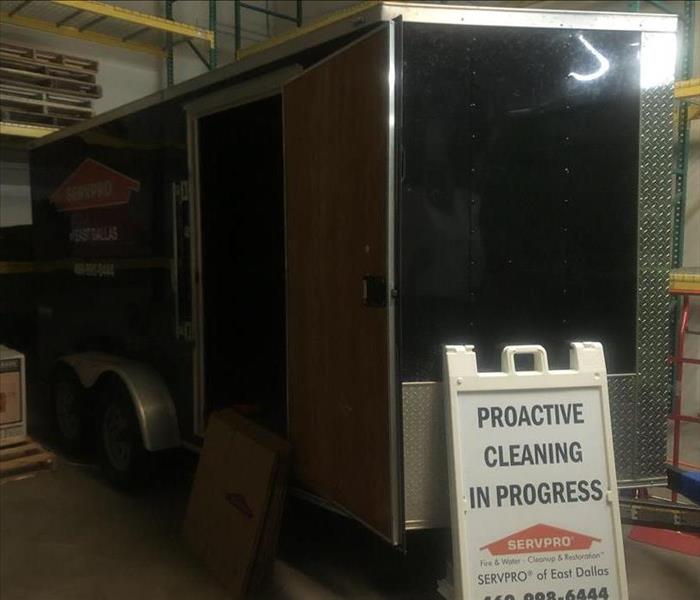 We are happy to provide fire damage clean up for all of Dallas and surrounding areas in East Dallas.
We are happy to provide fire damage clean up for all of Dallas and surrounding areas in East Dallas.
Fires can be devastating, leaving a trail of destruction that affects not just the physical structure but the morale and livelihood of everyone involved. Recently, a commercial building in East Dallas experienced such a tragedy. The fire, which broke out in the early hours of the morning, caused extensive damage to the structure and contents of the building. Fortunately, SERVPRO of East Dallas was there to help, bringing expertise, efficiency, and compassion to the cleanup and restoration process.
The Incident
The fire started in the building’s electrical system, quickly spreading to various sections of the property. By the time the fire department extinguished the blaze, significant portions of the building were charred, and smoke had permeated every corner. The business owners were left staring at the blackened ruins of their hard work and dedication. The road to recovery seemed daunting, but help was on the way.
The Call to Action
SERVPRO of East Dallas received the emergency call as soon as the fire was under control. Understanding the urgency, our team mobilized immediately. We knew that every moment counts when dealing with fire damage. Delays can lead to further damage from soot, smoke, and even water used to extinguish the fire.
Assessment and Planning
Upon arrival, our experienced technicians conducted a thorough assessment of the damage. This included evaluating structural damage, the extent of smoke and soot contamination, and the water damage from firefighting efforts. This detailed assessment allowed us to develop a comprehensive cleanup and restoration plan tailored to the specific needs of the building.
Immediate Cleanup
Our first priority was to secure the building and prevent further damage. We boarded up windows, placed tarps on the roof, and set up security measures. This was followed by the removal of debris, damaged materials, and standing water. Our team used advanced equipment to extract water and dry out affected areas, preventing mold growth and further deterioration.
Soot and Smoke Removal
Fire leaves behind not just visible soot, but also an invisible layer of smoke damage that can permeate walls, furniture, and even air ducts. Our team used specialized equipment and techniques to clean and deodorize the building. We employed air scrubbers, thermal fogging, and ozone treatments to remove smoke odor and improve air quality.
Restoring the Structure
Once the initial cleanup was complete, we turned our attention to restoring the building. This involved repairing structural damage, replacing drywall, repainting walls, and restoring floors. We worked diligently to ensure that the building was not just restored to its pre-fire condition but also safe for occupancy.
Content Restoration
In addition to structural repairs, we also focused on restoring the contents of the building. Using specialized cleaning methods, we restored furniture, documents, electronics, and other valuable items that were damaged by smoke and soot. Our goal was to salvage as much as possible, reducing the overall cost of recovery for the business owners.
Communication and Support
Throughout the process, we maintained open communication with the business owners, providing updates and addressing their concerns. We understand that dealing with a fire is a traumatic experience, and we strive to provide not just physical restoration but also emotional support.
Moving Forward
The road to recovery after a fire is never easy, but with the right team by your side, it becomes manageable. SERVPRO of East Dallas is committed to helping businesses get back on their feet after a disaster. Our expertise, advanced equipment, and compassionate approach make us the trusted choice for fire damage cleanup and restoration.
If your commercial building has suffered fire damage, don’t hesitate to reach out to SERVPRO of East Dallas. We are here to help you navigate the restoration process and restore hope amidst the ashes. Together, we can rebuild and move forward.
Restoring Hardwood Floors After Water Damage: A Comprehensive Guide
5/14/2024 (Permalink)
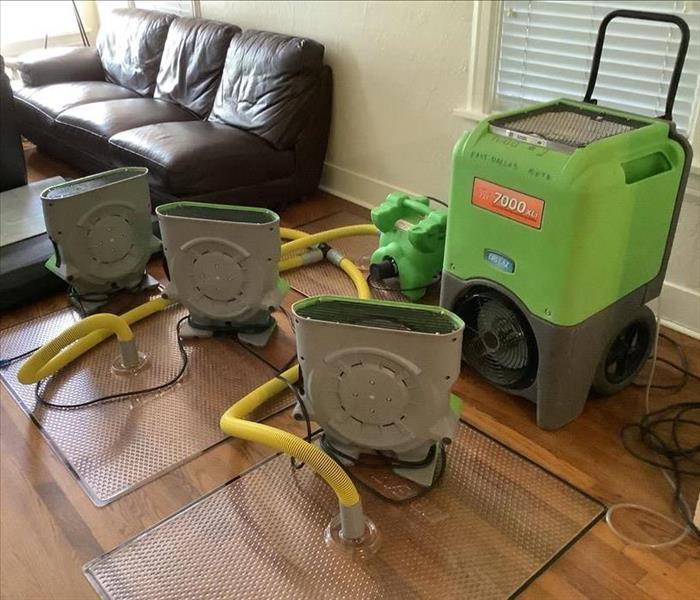 SERVPRO is on the job!
SERVPRO is on the job!
Hardwood floors add an unparalleled elegance and warmth to any home. However, when faced with water damage, their beauty can quickly turn into a homeowner's nightmare. Whether caused by a burst pipe, flooding, or an unexpected spill, water can cause significant harm to hardwood flooring. Understanding the steps to mitigate and repair this damage is crucial to preserving both the aesthetics and the integrity of your floors. Here, we delve into the process of addressing water damage on hardwood floors.
Understanding the Impact of Water on Hardwood
Water is hardwood’s nemesis. When wood absorbs water, it expands. As it dries, it contracts. This constant movement can lead to warping, cupping, buckling, and even cracking. Prolonged exposure can also foster mold growth, which poses additional health risks and complicates the restoration process.
Immediate Steps to Take After Water Exposure
- Act Quickly: The faster you respond, the better your chances of minimizing damage. Remove any standing water immediately using mops, towels, or a wet vacuum.
- Clear the Area: Move furniture, rugs, and other items away from the affected area to prevent further water absorption and to allow for better air circulation.
- Dry the Floor: Use fans, dehumidifiers, and open windows to enhance air flow and speed up the drying process. In some cases, professional drying equipment may be necessary to thoroughly remove moisture.
- Assess the Damage: Once the floor is dry, inspect for signs of warping, cupping, or buckling. It may take a few days to see the full extent of the damage as the wood stabilizes.
Professional Restoration Process
When dealing with significant water damage, it’s often best to consult professionals. Here’s what the restoration process typically involves:
- Moisture Measurement: Professionals use moisture meters to determine the extent of water saturation and to monitor the drying process.
- Controlled Drying: Specialized drying equipment, such as industrial-grade dehumidifiers and floor mats, ensures that moisture is removed efficiently without causing additional stress to the wood.
- Sanding and Refinishing: Once dry, the floors may need to be sanded to remove any cupping or warping. After sanding, refinishing restores the floor’s original appearance and provides a protective seal.
- Replacement: In cases of severe damage, some planks may need to be replaced entirely. Matching the new wood to the existing floor can be challenging but is essential for a seamless look.
Preventing Future Water Damage
- Seal Gaps: Ensure that there are no gaps between the floorboards and that the finish is intact. Regularly reseal hardwood floors to provide a barrier against moisture.
- Maintain Humidity Levels: Use a humidifier in the winter and a dehumidifier in the summer to maintain stable humidity levels in your home, preventing the wood from expanding and contracting excessively.
- Quick Response to Spills: Wipe up any spills immediately to prevent water from seeping into the wood.
- Inspect Regularly: Regularly check for signs of leaks from appliances, plumbing, or roofing that could lead to water damage.
Water damage to hardwood floors is a serious issue that requires prompt and effective action. By understanding the steps to take immediately after water exposure and the professional restoration process, you can save your floors from irreversible damage. Moreover, implementing preventative measures will help protect your hardwood floors from future water-related issues, ensuring they remain a beautiful feature in your home for years to come.
If you’re dealing with water-damaged hardwood floors, don’t hesitate to contact a professional restoration service. Their expertise and specialized equipment can make all the difference in reviving your beloved floors.
Trusted Water Damage Cleaning in Dallas
4/24/2024 (Permalink)
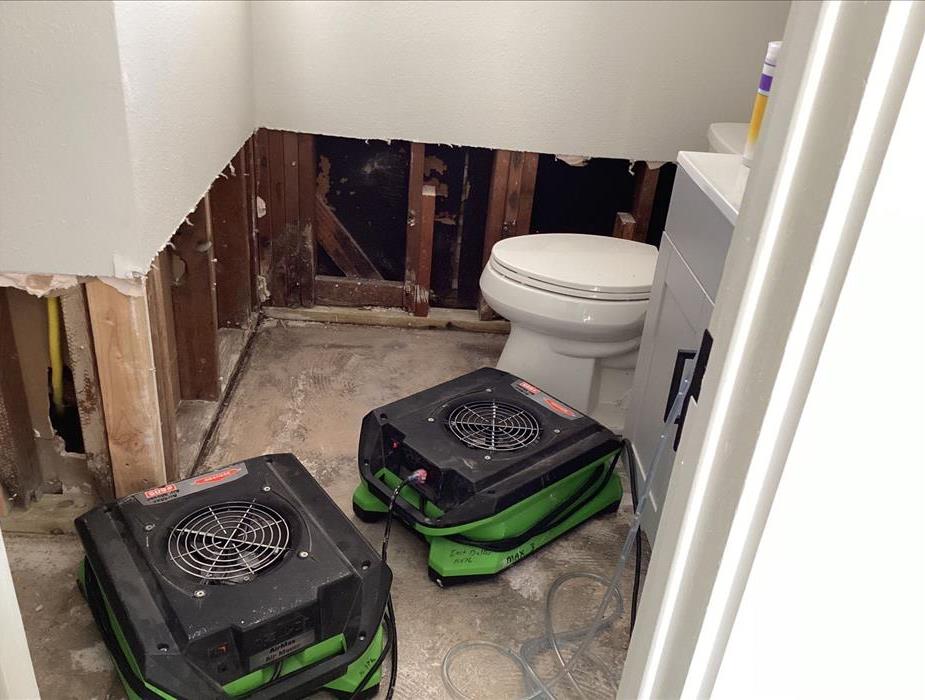 By following these steps and taking preventative measures, you can minimize the impact of water damage and keep your home safe and dry for years to co
By following these steps and taking preventative measures, you can minimize the impact of water damage and keep your home safe and dry for years to co
Water damage can strike unexpectedly, turning your sanctuary into a soggy mess. Whether it's from a burst pipe, flooding, or a leaky roof, the aftermath can be overwhelming. But fear not, residents of Dallas, because SERVPRO of East Dallas is here to guide you through the process of cleaning up water damage and restoring your home to its former glory.
Identify the Source: The first step in tackling water damage is to identify the source of the water intrusion. Is it from a broken pipe, a malfunctioning appliance, or external flooding? By pinpointing the source, you can take appropriate action to stop the flow of water and prevent further damage.
Safety First: Before diving into cleanup efforts, prioritize safety. Turn off the electricity to affected areas to reduce the risk of electrical hazards. If the water damage is extensive or the water appears contaminated, it's best to evacuate the premises and wait for professional assistance.
Assess the Damage: Once it's safe to do so, assess the extent of the water damage. Check for waterlogged walls, ceilings, floors, and furniture. Take photographs or videos for documentation purposes, especially if you plan to file an insurance claim.
Protecting Your Cabinets: A Guide to Preventing and Dealing with Water Damage
1/29/2024 (Permalink)
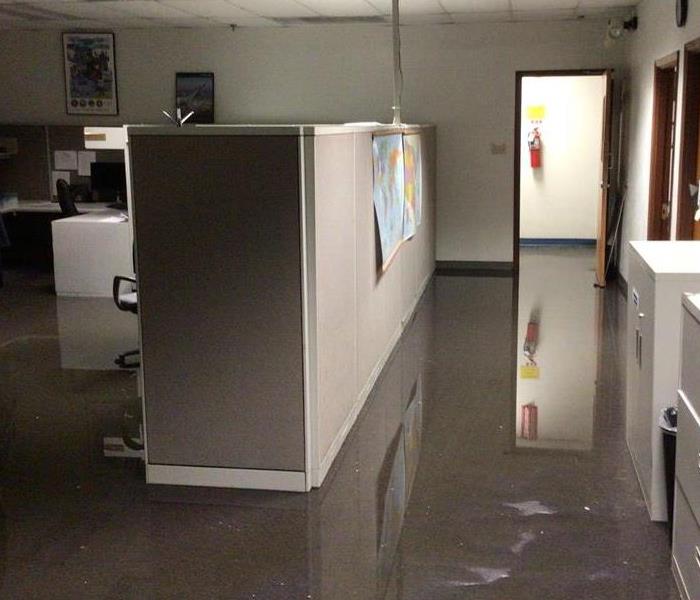 Water Damage can occur to any part of a building. Stay protected with these helpful tips!
Water Damage can occur to any part of a building. Stay protected with these helpful tips!
Cabinets are a significant investment in any home, both aesthetically and functionally. However, they are also susceptible to water damage, which can compromise their integrity and ruin their appearance. Whether it's a leaking pipe, a dishwasher malfunction, or a flood, water damage can wreak havoc on your cabinets if not addressed promptly and properly. In this blog post, we'll explore the causes of water damage to cabinets, how to prevent it, and what to do if your cabinets have already been affected. Today we are able to reach any size disaster in the same day. This allows us to be able to clean any disasters quickly! We can service all of East Dallas.
Understanding Water Damage to Cabinets: Water damage to cabinets can occur for various reasons, including:
Plumbing leaks: Leaking pipes under sinks or behind walls can lead to water pooling beneath or around cabinets, causing gradual damage over time.
Appliance malfunctions: Dishwashers, refrigerators with ice makers, and washing machines can leak water, particularly if their hoses or seals are damaged or improperly installed.
Flooding: Natural disasters like floods or heavy storms can inundate homes, causing extensive water damage to cabinets and other structures.
High humidity: Excessive moisture in the air, especially in poorly ventilated areas like kitchens and bathrooms, can cause cabinets to warp, swell, or develop mold.
Preventing Water Damage: Prevention is key to avoiding costly repairs and replacements. Here are some tips to prevent water damage to your cabinets:
Regular maintenance: Inspect plumbing fixtures, appliances, and cabinets regularly for any signs of leaks or damage. Fix any issues promptly to prevent water from seeping into your cabinets.
Install water detection devices: Consider installing water leak detectors or alarms near sinks, appliances, and other water sources to alert you to any leaks before they cause significant damage.
Seal gaps and cracks: Seal gaps around pipes, faucets, and seams where cabinets meet the wall to prevent water from seeping in.
Use waterproof materials: When renovating or installing cabinets, opt for materials that are resistant to water damage, such as marine-grade plywood or water-resistant laminate.
Maintain proper ventilation: Ensure adequate ventilation in areas prone to moisture buildup, such as kitchens and bathrooms, to reduce the risk of condensation and mold growth.
Dealing with Water Damage: Despite your best efforts, water damage may still occur. If you discover water damage to your cabinets, here's what you should do:
Act quickly: Immediately remove any standing water and thoroughly dry the affected area to prevent further damage and mold growth.
Assess the extent of the damage: Determine whether the cabinets can be salvaged or if they need to be replaced. Consult with a professional if necessary.
Repair or replace damaged cabinets: Depending on the severity of the damage, you may need to repair or replace the affected cabinets. Consult with a reputable contractor or cabinet specialist for guidance.
Address underlying issues: Identify and address the root cause of the water damage, whether it's a plumbing issue or poor ventilation, to prevent future incidents.
Conclusion: Water damage to cabinets can be a homeowner's nightmare, but with proper prevention measures and prompt action, you can minimize the risk and mitigate the damage. By staying vigilant, maintaining your cabinets, and addressing any issues promptly, you can protect your investment and enjoy beautiful, functional cabinets for years to come.
Call SERVPRO of East Dallas when it comes to your water damaged home or building.
Winter Damage Cleanup Company in Dallas
1/16/2024 (Permalink)
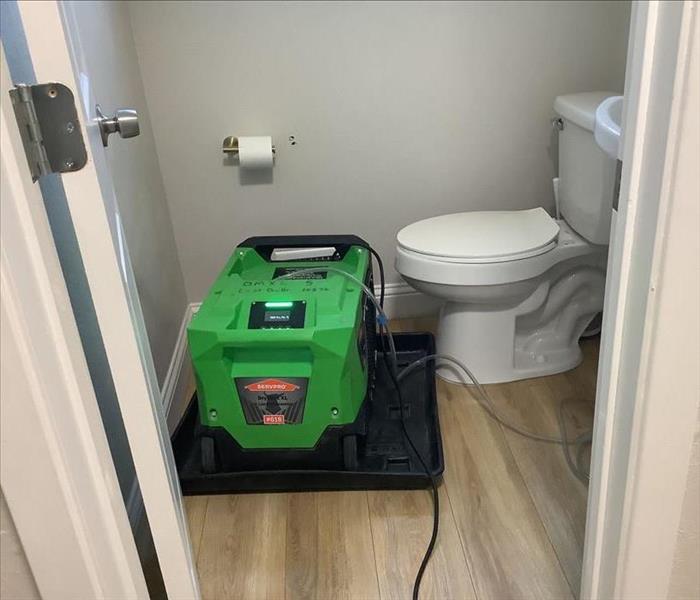 We have all the tools and experience needed to handle any size disaster.
We have all the tools and experience needed to handle any size disaster.
SERVPRO of East Dallas has the tools and experience when dealing with water damage caused by winter freeze can be challenging, but it's important to address it promptly to prevent further issues. Here are some general steps you can take for winter freeze water damage cleanup:
Safety First:
- Ensure your safety before entering the affected area. If there's a risk of electrical shock, turn off the power in the affected area.
Assess the Damage:
- Evaluate the extent of the water damage. Identify areas affected by water and take note of the severity.
Remove Standing Water:
- Use a wet/dry vacuum, buckets, or a pump to remove standing water. The quicker you remove the water, the better chance you have of minimizing damage.
Dry the Area:
- Use fans, dehumidifiers, and open windows to facilitate drying. Thoroughly dry the affected areas to prevent mold growth.
Remove Damaged Materials:
- Discard irreparably damaged items such as soaked carpets, insulation, and other porous materials. Mold can develop quickly, so prompt removal is crucial.
Clean and Disinfect:
- Clean and disinfect the affected areas to prevent mold and bacterial growth. Use appropriate cleaning agents and follow safety guidelines.
Inspect for Structural Damage:
- Check for any structural damage to walls, floors, or ceilings. If you suspect structural issues, consult with a professional.
Repair and Restore:
- Once the area is completely dry and free of damage, proceed with repairs. This may include replacing drywall, insulation, and flooring.
Prevent Future Issues:
- Take measures to prevent future water damage. Insulate pipes, seal gaps, and consider adding extra insulation to vulnerable areas.
Insurance Claim:
- If you have insurance coverage for water damage, contact your insurance provider and document the damage for the claims process.
If you are in Dallas and surrounding areas we are ready to help with this winter warm. A frozen pipe burst or winter damage situation can bring stress to any Dallas homeowner. We have same day technicians and experienced help to handle any size situation! Our office is located right in Dallas so this allows us to reach any size disaster in a timely manner. Give us a call today if you experienced any of these disasters.
Preventing Pipe Bursts
12/27/2023 (Permalink)
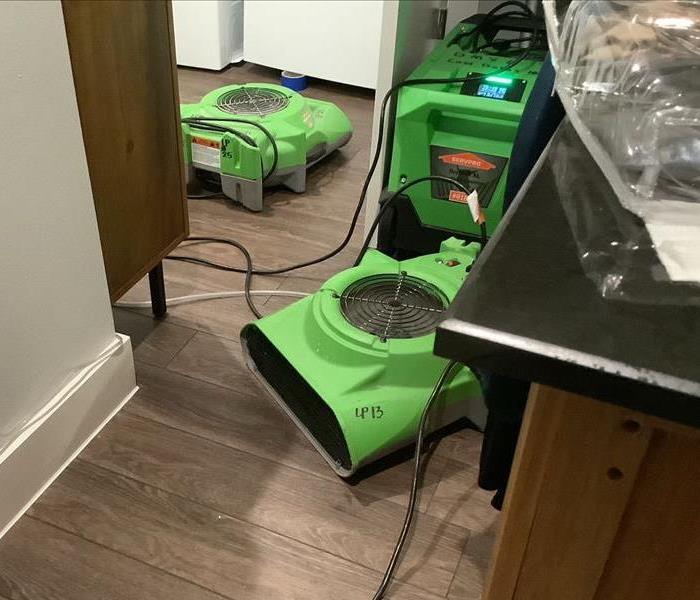 SERVPRO of East Dallas has been preventing pipe busts all this year!
SERVPRO of East Dallas has been preventing pipe busts all this year!
Picture this: it's a chilly winter morning, and you're enjoying a cup of coffee when suddenly, you hear a loud pop followed by the ominous sound of rushing water. Your heart sinks as you discover a burst pipe, causing a mess and potentially damaging your home. Pipe bursts can be a homeowner's nightmare, but with proactive measures, you can significantly reduce the risk of such disasters. In this blog, we'll explore practical tips and strategies to prevent pipe bursts and safeguard your home.
- Insulate Your Pipes:
One of the leading causes of pipe bursts is freezing temperatures. When water inside pipes freezes, it expands, exerting pressure on the pipe walls. This pressure can lead to cracks and eventual bursts. To prevent this, insulate your pipes, especially those exposed to colder areas such as basements, attics, or crawl spaces. Pipe insulation sleeves or heat tape can be effective in maintaining a stable temperature.
- Maintain Adequate Heating:
Ensuring proper heating throughout your home is crucial in preventing pipes from freezing. Keep your thermostat set to a consistent temperature, especially during winter nights when temperatures tend to drop significantly. If you're away from home, consider leaving the heating on at a lower but consistent temperature to prevent pipes from reaching freezing temperatures.
- Seal Leaks Promptly:
Even small leaks can lead to big problems over time. Regularly inspect your plumbing for any signs of leaks and address them promptly. A dripping faucet may seem insignificant, but the continuous flow of water can contribute to pipe corrosion and weaken the structure, making it more susceptible to bursts.
- Disconnect and Drain Outdoor Hoses:
Before winter sets in, disconnect and drain water from outdoor hoses. Leaving water in the hoses can lead to freezing, causing backpressure that may affect connected indoor pipes. Store hoses in a sheltered area to prevent exposure to harsh weather conditions.
- Install a Water Softener:
Hard water, characterized by a high mineral content, can accelerate pipe corrosion and reduce their lifespan. Consider installing a water softener to minimize mineral deposits in your plumbing system. This not only extends the life of your pipes but also enhances overall water quality.
- Regularly Flush Your Water Heater:
Sediment buildup in your water heater can compromise its efficiency and contribute to pipe corrosion. Follow the manufacturer's guidelines to flush your water heater regularly, removing sediment and preventing potential damage to both the heater and connected pipes.
- Be Mindful of Water Pressure:
Excessively high water pressure can stress your plumbing system, increasing the risk of pipe bursts. Install a pressure regulator to maintain a safe and consistent water pressure level throughout your home. Regularly monitor your water pressure and address any irregularities promptly.
Returning To A Water Damaged Home
11/9/2023 (Permalink)
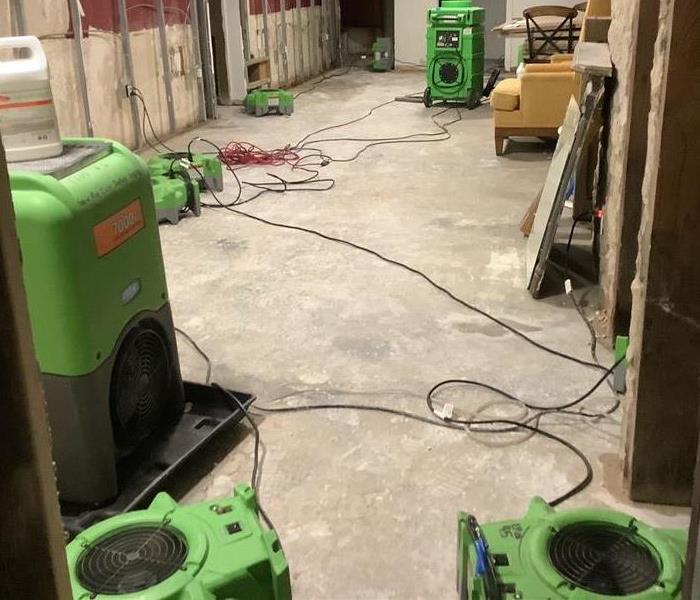 Returning to a water damaged home isn't fun but we have the equipment needed to restore your home back to normal.
Returning to a water damaged home isn't fun but we have the equipment needed to restore your home back to normal.
Returning to a water-damaged home can be overwhelming and distressing. It's crucial to approach the situation with caution and follow proper safety measures to minimize risks. Here's a step-by-step guide on what to do if you're returning to a home that has been damaged by water:
1. Ensure Safety:
- Do not enter if it's unsafe: If there is still standing water or the structure of the building is compromised, do not enter the home. Contact a professional to assess the safety of the building.
- Turn off utilities: If it's safe to do so, turn off electricity, gas, and water to prevent further damage and reduce the risk of electrical hazards.
2. Document the Damage:
- Take photographs and videos: Document the damage for insurance purposes. Capture as many details as possible to support your insurance claim.
- Make a list: Create an inventory of damaged items. Note their description, approximate value, and the date of purchase if possible.
3. Contact Your Insurance Company:
- File a claim: Contact your insurance company as soon as possible to report the damage. Provide them with the documentation you've collected.
4. Water Removal and Cleanup:
- Remove standing water: Hire professionals to pump out standing water from the property.
- Dry out the area: Use fans, dehumidifiers, and open windows to help dry out the affected areas. Mold can start growing within 24-48 hours, so it's essential to dry the space quickly.
- Dispose of damaged items: Remove and properly dispose of items that cannot be salvaged, as they can harbor mold and bacteria.
5. Professional Assessment and Repairs:
- Get professional assessments: Have professionals assess the extent of the damage, including structural damage and potential health hazards.
- Begin repairs: Work with reputable contractors and restoration professionals to repair and restore your home. This may include repairing drywall, flooring, and electrical systems.
6. Prevent Mold Growth:
- Mold prevention: Act quickly to prevent mold growth. Clean and disinfect all affected areas. Consider using mold inhibitors on walls and surfaces.
- Proper ventilation: Ensure proper ventilation in the affected areas to promote drying and prevent moisture buildup.
7. Health Precautions:
- Protective gear: Wear appropriate protective clothing, gloves, and masks to avoid direct contact with contaminated water and materials.
- Vaccinations: Ensure your tetanus vaccination is up-to-date, especially if you have any cuts or injuries.
8. Emotional Support:
- Seek support: Dealing with the aftermath of water damage can be emotionally draining. Reach out to friends, family, or support groups for emotional support.
9. Prevent Future Incidents:
- Identify the cause: Determine the cause of the water damage (e.g., burst pipes, flooding) and take necessary steps to prevent future incidents.
- Consider preventive measures: Invest in a sump pump, waterproofing, or other measures to protect your home from future water damage.
Remember that recovering from water damage takes time and effort. Be patient and thorough in the recovery process, and don't hesitate to seek professional help when needed.
The Creepy Tales of Water Damage in your Dallas Home
10/26/2023 (Permalink)
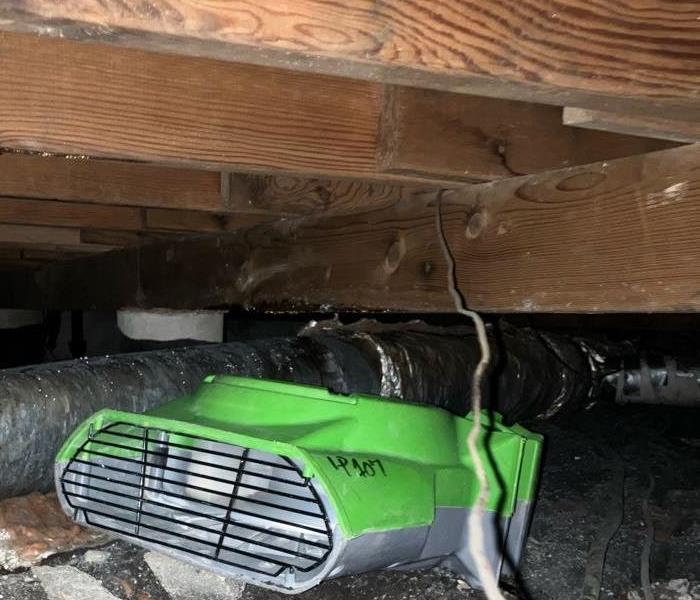 There can be water damage in spots where you hardly walk.
There can be water damage in spots where you hardly walk.
Leaving water damage untreated can lead to a variety of severe issues, both immediate and long-term. Here are some of the worst consequences of neglecting water damage:
Structural Damage: Water can weaken the structural integrity of buildings. Over time, untreated water damage can compromise the foundation, walls, and overall stability of a structure.
Mold Growth: Mold thrives in damp environments. If water damage is not properly addressed, it creates an ideal breeding ground for mold. Mold not only causes health problems but can also lead to extensive property damage.
Health Risks: Stagnant water can become contaminated with bacteria, viruses, and other harmful microorganisms. Exposure to these contaminants can lead to various health issues, particularly respiratory problems and infections.
Electrical Hazards: Water and electricity are a dangerous combination. Untreated water damage can seep into electrical systems, creating a risk of electrical fires and shocks. This poses a significant threat to both the property and its occupants.
Damage to Belongings: Water damage can ruin personal belongings, including furniture, electronics, documents, and sentimental items. In many cases, these items cannot be salvaged once they are extensively damaged by water.
Odor and Discoloration: Standing water and dampness can lead to unpleasant odors and discoloration of walls, ceilings, and floors. These issues are not only unappealing but also difficult and expensive to eliminate without professional intervention.
Decreased Property Value: Untreated water damage significantly diminishes the value of a property. Potential buyers are likely to be deterred by the visible damage and the potential for hidden problems like mold and compromised structural integrity.
Increased Repair Costs: Delaying water damage repairs allows the damage to spread and worsen over time. This often results in higher repair costs, as the scope of the damage expands, necessitating more extensive restoration efforts.
Insurance Issues: Insurance policies often require homeowners to mitigate damages promptly. Failing to address water damage in a timely manner can lead to complications with insurance claims, leaving the property owner responsible for the full cost of repairs.
Legal Consequences: If untreated water damage causes harm to neighboring properties or renters, legal consequences, including liability for damages, may arise. Ignoring the issue can lead to legal disputes and financial liabilities.
Addressing water damage promptly and thoroughly is crucial to preventing these severe consequences. It is recommended to seek professional help to assess the damage and carry out appropriate restoration and repairs.
Fixing a Water Damage Home isn't too Easy
9/21/2023 (Permalink)
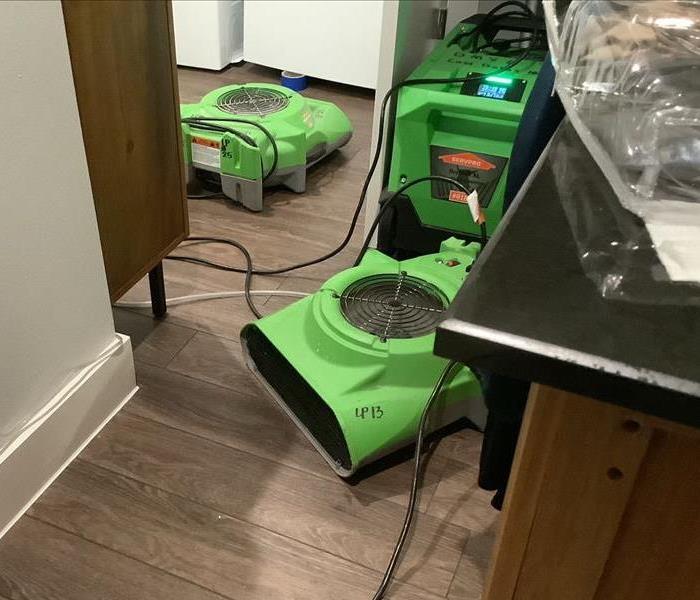 We are here to help your water damaged home.
We are here to help your water damaged home.
Cleaning up a water-damaged home is a crucial step to prevent further damage and mold growth. Here's a step-by-step guide on how to clean up after water damage in your home:
Ensure Safety First:
- Before entering a water-damaged area, make sure it's safe to do so. Check for electrical hazards, structural damage, and any other potential dangers. Turn off the electricity and gas supply to the affected area if necessary.
Stop the Source of Water:
- Identify and stop the source of water leakage or flooding. This may involve shutting off the main water supply, repairing a burst pipe, or sealing a leak.
Document the Damage:
- Take photos or videos of the water damage for insurance purposes. This will help with your insurance claim.
Remove Standing Water:
- Use a wet-dry vacuum, sump pump, or buckets to remove standing water. The faster you can remove water, the better chance you have of preventing further damage and mold growth.
Dispose of Damaged Items:
- Discard items that cannot be salvaged, such as saturated carpeting, insulation, and drywall. Be sure to document these items for insurance claims.
Dry the Area:
- Use fans, dehumidifiers, and open windows to help dry the affected area. This process can take several days, so be patient.
Disinfect and Clean:
- Clean and disinfect all surfaces that came into contact with the floodwater. Use a solution of bleach and water (one cup of bleach to one gallon of water) for this purpose. Wear gloves and ensure proper ventilation when working with bleach.
Remove Mold and Mildew:
- If mold has already started to grow, you may need to remove affected materials like drywall and insulation. Consult with professionals for extensive mold infestations.
Check for Structural Damage:
- Inspect the structural integrity of your home, including the foundation, walls, and floors. Water damage can weaken these elements.
Repair and Restore:
- Once the area is completely dry and free of mold, repair or replace damaged materials, such as drywall and insulation. Ensure that any repairs are up to code.
Prevent Future Water Damage:
- Take steps to prevent future water damage, such as installing sump pumps, maintaining gutters, and repairing roof leaks.
Consult Professionals:
- For severe water damage or mold infestations, it's advisable to consult with professionals who specialize in water damage restoration and mold remediation. They have the expertise and equipment to handle extensive damage.
Contact Your Insurance Company:
- Notify your insurance company about the damage and follow their instructions for filing a claim. Keep records of all expenses related to the cleanup and repairs.
Remember that water damage can lead to structural problems and health hazards, so it's crucial to address it promptly and thoroughly. If in doubt or dealing with extensive damage, seek professional assistance to ensure the safety and integrity of your home.
The Insurance Process When It Comes to Restoration Companies
9/19/2023 (Permalink)
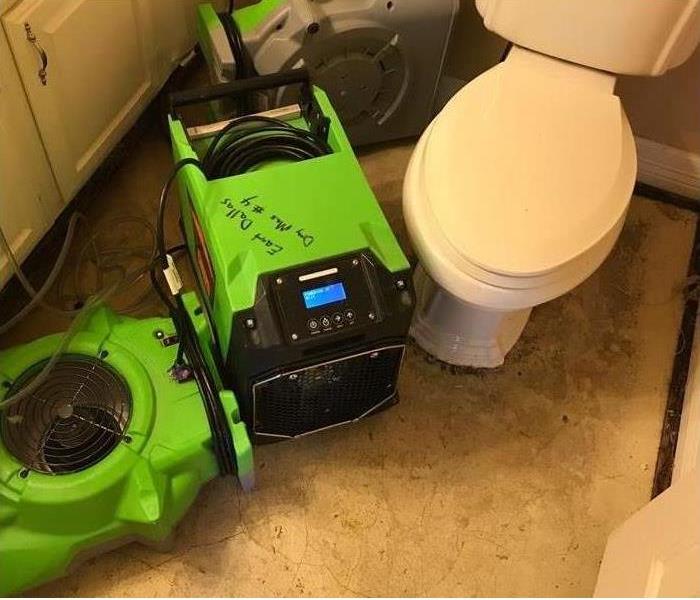 SERVPRO has the machines & equipment ready to get the job done!
SERVPRO has the machines & equipment ready to get the job done!
The insurance process for remediation companies, such as those involved in disaster recovery, environmental cleanup, or restoration services, typically involves several steps. Here's an overview of how it works:
Assessment and Initial Contact:
- When a property owner or business faces a situation that requires remediation services (e.g., water damage, fire damage, mold infestation, hazardous material cleanup), they typically contact a remediation company.
Initial Inspection and Estimate:
- The remediation company conducts an initial inspection of the damage or contamination to assess the scope of work required.
- They provide the property owner with an estimate of the costs involved, which includes labor, equipment, materials, and any other necessary expenses.
Insurance Verification:
- If the property owner has insurance coverage that may apply to the remediation services, they contact their insurance company to verify coverage and file a claim if necessary.
- The insurance company assigns an adjuster to assess the situation and determine if the claim is valid.
Claim Approval:
- If the insurance company approves the claim, they will work with the property owner and the remediation company to determine coverage limits and any deductibles.
- The insurance company may also specify which services are covered and to what extent.
Work Commencement:
- Once the insurance details are settled, the remediation company can begin the cleanup and restoration work.
- They typically follow industry standards and guidelines for the specific type of remediation required.
Documentation:
- Throughout the remediation process, the remediation company keeps detailed records of the work performed, including photographs, invoices, and reports.
- They submit these documents to the insurance company for reimbursement.
Insurance Claims Processing:
- The insurance company reviews the submitted documentation and processes the claim.
- They may conduct additional inspections or request more information if needed.
Payment and Reimbursement:
- Once the claim is approved, the insurance company will issue payment directly to the remediation company for the covered expenses.
- The property owner is responsible for any deductibles or costs exceeding the coverage limits.
Completion of Work:
- The remediation company continues working until the property is fully restored or the contamination is removed to the satisfaction of all parties involved.
Final Inspection and Sign-off:
- After the remediation work is completed, a final inspection is often conducted to ensure that all work meets the required standards and that the property is safe for occupancy or use.
Claim Closure:
- Once the property owner and insurance company are satisfied with the work, the insurance claim is closed.
It's important for property owners to understand their insurance policy's terms and coverage limits, as well as any responsibilities they have in the claims process. Remediation companies must also maintain proper documentation and communication with both the property owner and the insurance company to ensure a smooth and successful claims process.
Most Common Causes of Water Damage
9/19/2023 (Permalink)
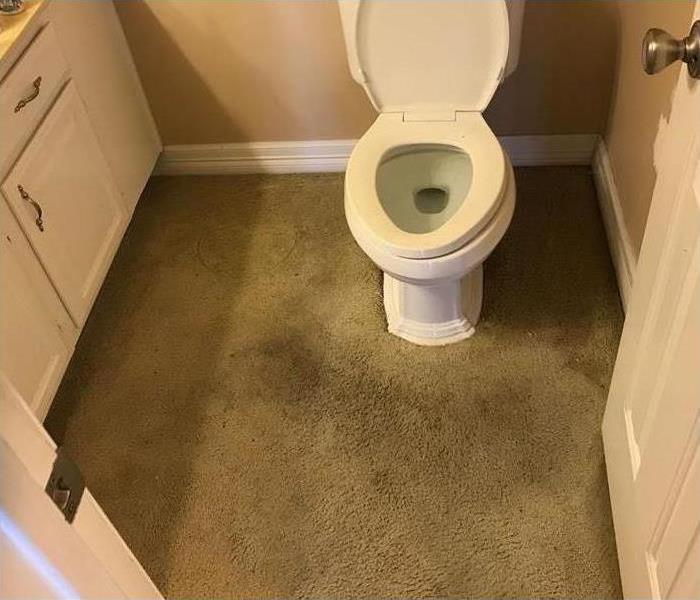 This restroom was not safe from water damage.
This restroom was not safe from water damage.
Water damage can result from various sources, and it's a common issue that can cause significant property damage and financial losses. Here are some of the most common causes of water damage:
Leaking or Burst Pipes: Plumbing issues, such as leaking or burst pipes, can lead to water damage. This can occur due to corrosion, freezing temperatures, high water pressure, or physical damage to the pipes.
Appliance Malfunctions: Household appliances like washing machines, dishwashers, refrigerators, and water heaters can develop leaks or malfunction, causing water to flood the surrounding areas.
Roof Leaks: Damaged or deteriorating roofs can allow rainwater to penetrate the structure, leading to ceiling leaks, attic damage, and interior water damage.
Clogged or Backed-Up Drains: Blocked sewer lines or drains can result in wastewater backing up into sinks, toilets, or bathtubs. This contaminated water can cause significant damage and health hazards.
Heavy Rain and Storms: Severe weather events, including heavy rainfall, hurricanes, and flash floods, can overwhelm drainage systems and lead to water infiltration into homes and businesses.
Foundation Cracks: Cracks in a building's foundation can allow groundwater to seep into basements and crawl spaces, causing structural damage and mold growth.
Malfunctioning Sump Pumps: Sump pumps are designed to prevent basement flooding by pumping out excess water. When these pumps fail or lose power during a storm, basements can flood.
Poorly Sealed Windows and Doors: Improperly sealed windows and doors can allow rainwater to infiltrate, leading to interior water damage and mold growth.
HVAC Issues: Problems with heating, ventilation, and air conditioning (HVAC) systems, such as condensation buildup or clogged drain lines, can result in water damage.
Natural Disasters: Events like earthquakes, tsunamis, and wildfires can cause widespread water damage through various mechanisms, including flooding, mudslides, and firefighting efforts.
Humidity and Condensation: High indoor humidity levels and condensation can promote mold growth and structural damage over time, especially in poorly ventilated areas.
Bathroom Leaks: Leaks around showers, bathtubs, sinks, and toilets can occur due to deteriorating caulk or grout, leading to water damage in adjacent areas.
Ice Dams: In cold climates, ice dams can form on roofs, preventing proper drainage of melted snow and ice. This can result in roof leaks and interior water damage.
Gutter and Downspout Issues: Clogged or damaged gutters and downspouts can cause rainwater to overflow and pool near the foundation, potentially leading to basement flooding.
Lack of Maintenance: Neglecting regular maintenance, such as inspecting and repairing potential problem areas, can contribute to various water damage issues.
Preventing water damage often involves routine maintenance, timely repairs, and proper installation of water-resistant materials. In cases where water damage occurs, it's crucial to address it promptly to prevent further damage and mitigate potential health risks associated with mold and mildew growth. Homeowners and property managers should also consider having appropriate insurance coverage to help mitigate the financial impact of water damage events.
Signs of Water Damage in Dallas Homes
9/13/2023 (Permalink)
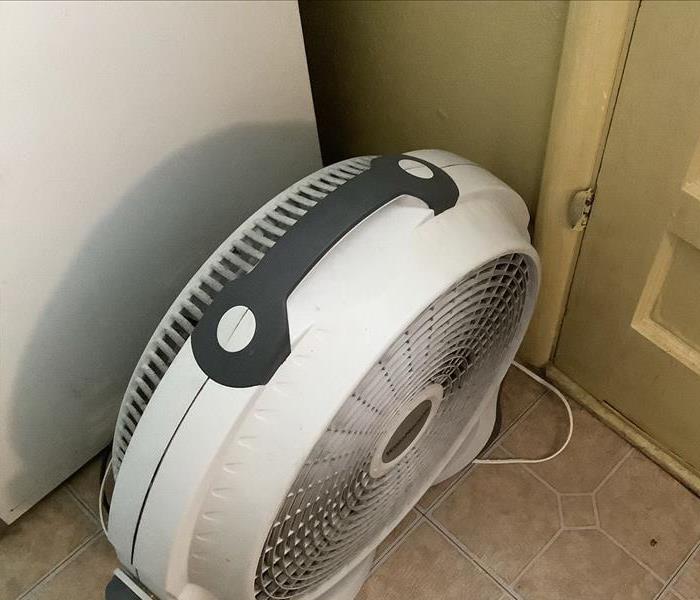 Dallas homes aren't safe from water damage. They are times when walls start to acquire moisture.
Dallas homes aren't safe from water damage. They are times when walls start to acquire moisture.
Water damage in walls can be a serious issue, as it can lead to structural problems and mold growth if left untreated. It's important to be able to recognize the signs of water damage in walls so that you can address the issue promptly. Here are some common signs of water damage in walls:
Discoloration: One of the most noticeable signs of water damage is discoloration on the wall surface. Look for patches of brown, yellow, or grayish stains that may appear in irregular shapes.
Bubbling or peeling paint or wallpaper: When water gets behind the wall's surface, it can cause the paint or wallpaper to bubble, peel, or blister. This is often an indication of moisture trapped beneath the wall covering.
Sagging or warping: Water damage can cause the wallboard or drywall to become saturated and lose its structural integrity. As a result, you may notice areas where the wall appears to sag or warp.
Soft or mushy drywall: Gently press on the wall with your fingers or a tool like a screwdriver. If the drywall feels soft, mushy, or crumbles easily, it likely has water damage.
Swelling or expansion: Water can cause materials like wood or drywall to swell or expand. If you notice bulging or protruding areas on the wall, it may be a sign of water damage.
Musty odor: Water damage often leads to the growth of mold and mildew, which can produce a musty or damp odor. If you detect a persistent unpleasant smell in a specific area, it may be a sign of hidden water damage.
Visible mold growth: Sometimes, water damage leads to the growth of mold, which can appear as black, green, or brown spots on the wall. Mold growth is a clear sign of ongoing moisture issues.
Efflorescence: In the case of water damage caused by water infiltration from outside, you might notice a white, powdery substance called efflorescence on the surface of the wall. This occurs when water carries minerals to the surface and evaporates, leaving mineral deposits behind.
Water stains on baseboards or nearby surfaces: Water can travel horizontally within walls and leave stains or damage on baseboards, adjacent walls, or the ceiling below the affected area.
Increased utility bills: If you notice a sudden increase in your water or heating/cooling bills, it could be a sign of a hidden water leak within your walls.
If you suspect water damage in your walls, it's crucial to address the issue promptly to prevent further damage and potential health hazards associated with mold growth. Consider hiring a professional contractor or a water damage restoration specialist to assess the extent of the damage and carry out necessary repairs.
What can water damage do to your home?
9/12/2023 (Permalink)
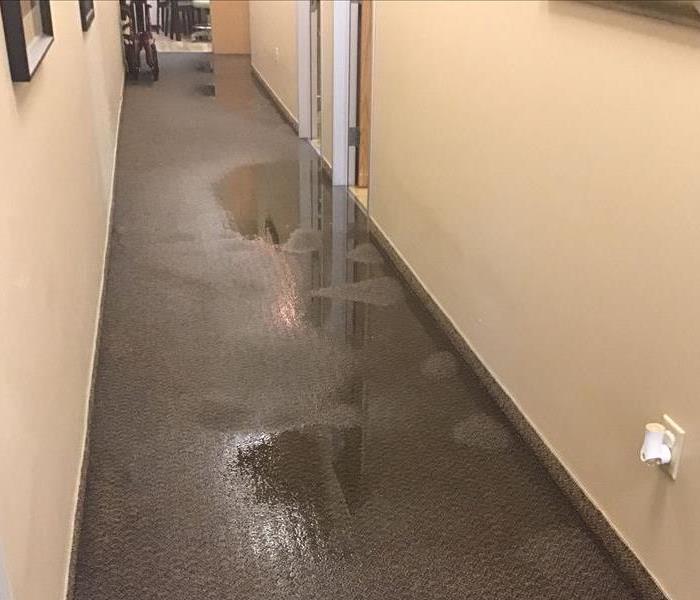 Water Damage, if not cleaned up may cause years of damage.
Water Damage, if not cleaned up may cause years of damage.
Water damage can have serious and long-lasting effects on your home. It can result from various sources, such as leaks, floods, burst pipes, or even high humidity levels. Here are some of the common ways water damage can affect your home:
Structural Damage: Water can weaken the structural integrity of your home. It can damage the foundation, walls, ceilings, and floors. Over time, this can lead to costly repairs or even compromise the safety of your home.
Mold and Mildew Growth: Moisture provides an ideal environment for mold and mildew to thrive. Mold can grow on various surfaces, including drywall, wood, and insulation. It not only damages these materials but also poses health risks to occupants.
Electrical Issues: Water damage can damage electrical systems and appliances in your home. This can lead to short circuits, electrical fires, or appliance malfunctions. Electrical problems are particularly dangerous, as they can cause safety hazards.
Health Risks: Mold and mildew growth resulting from water damage can trigger allergies, respiratory problems, and other health issues in occupants. Prolonged exposure to damp conditions can lead to health concerns.
Reduced Property Value: Homes with a history of water damage may lose value in the real estate market. Potential buyers are often wary of purchasing homes with a history of water damage due to the potential for hidden problems and the cost of repairs.
Pest Infestations: Moisture attracts pests such as termites, cockroaches, and rodents. These pests can cause additional damage to your home and pose health risks.
Aesthetic Damage: Water damage can leave unsightly stains on walls, ceilings, and floors. These stains can be challenging to remove and may require repainting or refinishing.
Odor: Stagnant water and mold growth can create unpleasant odors in your home. These odors can persist even after the visible damage is repaired.
Insulation Damage: Insulation materials can absorb water, reducing their effectiveness. This can lead to increased energy costs as your HVAC system works harder to maintain a comfortable temperature.
Weakened Foundation: If water damage affects the foundation of your home, it can lead to settling, cracks, and structural issues. These problems can be expensive to repair and compromise the stability of your house.
To prevent water damage and mitigate its effects, it's essential to maintain your home, address any leaks or plumbing issues promptly, and take steps to ensure proper drainage and moisture control. Regular inspections and maintenance can help you identify and address potential water damage issues before they become major problems.
SERVPRO History Lesson: Dallas Floods
8/14/2023 (Permalink)
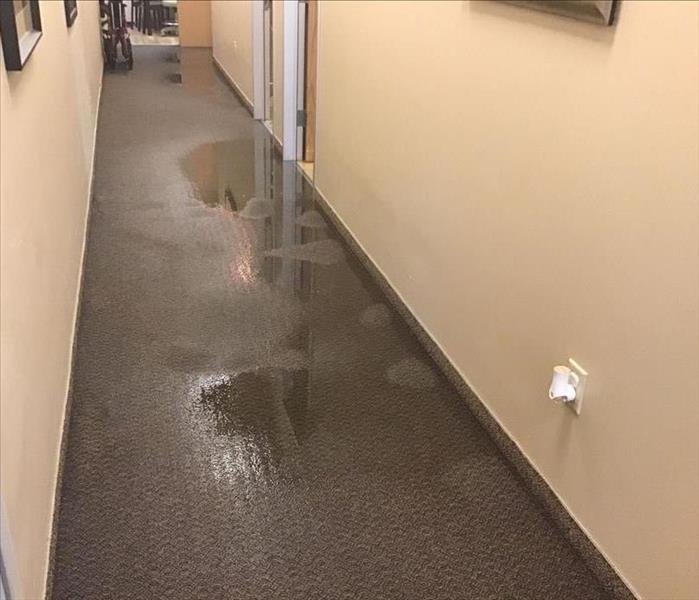 Due to a Dallas Flood, this hallway had water running through it.
Due to a Dallas Flood, this hallway had water running through it.
Dallas, Texas, has a history of flooding due to its geographical location and the presence of several rivers and creeks. Flooding events have occurred over the years, causing damage to infrastructure, property, and sometimes even loss of life. Here are some notable flood events in Dallas history:
1908 Trinity River Flood: One of the most devastating floods in Dallas history, this event occurred in May 1908. The Trinity River overflowed due to heavy rainfall, causing significant damage to the city and resulting in the loss of lives and property.
1922 Trinity River Flood: Another major flood event took place in 1922, causing widespread destruction and prompting the city to implement flood control measures.
1935 Trinity River Flood: This flood was a result of heavy rains upstream that caused the Trinity River to rise rapidly. The flooding led to further discussions about the need for improved flood protection.
1945 Trinity River Flood: This flood event prompted the creation of the Dallas Floodway Extension Project, which aimed to construct a levee system to provide better flood control.
1990 Flash Flood: In May 1990, Dallas experienced a flash flood event due to heavy rainfall. The flooding caused damage to homes, roads, and infrastructure, leading to discussions about urban planning and flood prevention.
2015 and 2016 Floods: In May 2015 and April 2016, heavy rains caused flooding in parts of Dallas, leading to road closures, property damage, and water rescues.
June 2019 Flash Floods: In June 2019, heavy rainfall led to flash flooding in several areas of Dallas, impacting roads and causing travel disruptions.
The city of Dallas has undertaken various flood control and mitigation measures over the years to reduce the impact of flooding events. The Trinity River Project, for instance, has involved building levees, floodways, and reservoirs to better manage floodwaters. Additionally, urban planning and development regulations have been put in place to reduce the risk of flooding in new construction.
It's important to note that while flood control efforts have improved over time, the risk of flooding remains a concern, particularly during periods of heavy rainfall. Local authorities and emergency management agencies work to monitor weather conditions and provide timely warnings to residents when flooding is imminent.
SERVPRO of East Dallas History Lesson: Biggest Floods in Dallas History
8/9/2023 (Permalink)
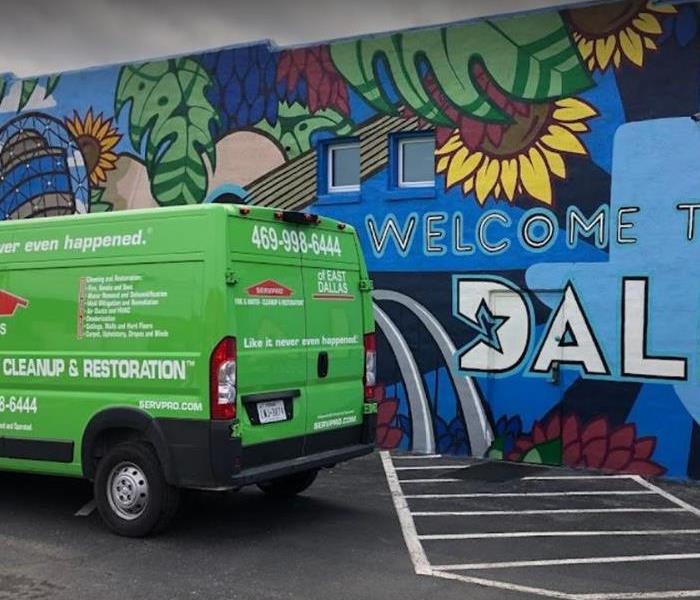 SERVPRO is no fan of floods, but when we see them we now how to handle.
SERVPRO is no fan of floods, but when we see them we now how to handle.
SERVPRO of East Dallas love to call Dallas, Texas home! Unfortunately we have experienced several significant floods throughout its history. Here are some of the most notable ones:
Trinity River Flood of 1908: One of the most devastating floods in Dallas history occurred in 1908 when heavy rains caused the Trinity River to overflow its banks. The floodwaters inundated parts of the city, causing widespread damage to homes, businesses, and infrastructure.
Trinity River Flood of 1922: In 1922, heavy rainfall led to another major flood along the Trinity River. The floodwaters affected numerous areas in Dallas and caused significant destruction.
June 1935 Flood: In June 1935, heavy rains caused extensive flooding across North Texas, including Dallas. The flooding led to evacuations, property damage, and disruptions to transportation and utilities.
June 1941 Flood: Another significant flood occurred in June 1941 when heavy rainfall resulted in widespread flooding in Dallas and other parts of the region. The floodwaters caused damage to homes, businesses, and agricultural areas.
June 1990 Flood: In June 1990, heavy rains caused flash flooding in Dallas and the surrounding areas. The flooding led to evacuations, road closures, and property damage.
October 2015 Flood: In October 2015, North Texas experienced heavy rainfall, leading to flooding in various areas, including Dallas. The floodwaters affected roadways, homes, and businesses.
May 2019 Flood: In May 2019, severe weather and heavy rainfall caused flooding in parts of Dallas and North Texas. The flooding resulted in water rescues, road closures, and property damage.
It's important to note that these are just a few examples of significant floods that have occurred in Dallas. Flooding can result from various factors, including heavy rainfall, rapid snowmelt, and overflowing rivers. Local authorities and organizations work to manage and mitigate flood risks through improved infrastructure, floodplain management, and emergency response plans. For more detailed information about specific floods and their impacts, local historical archives and government records would be valuable sources to explore.
Why to Hire a East Dallas Restoration Company
7/25/2023 (Permalink)
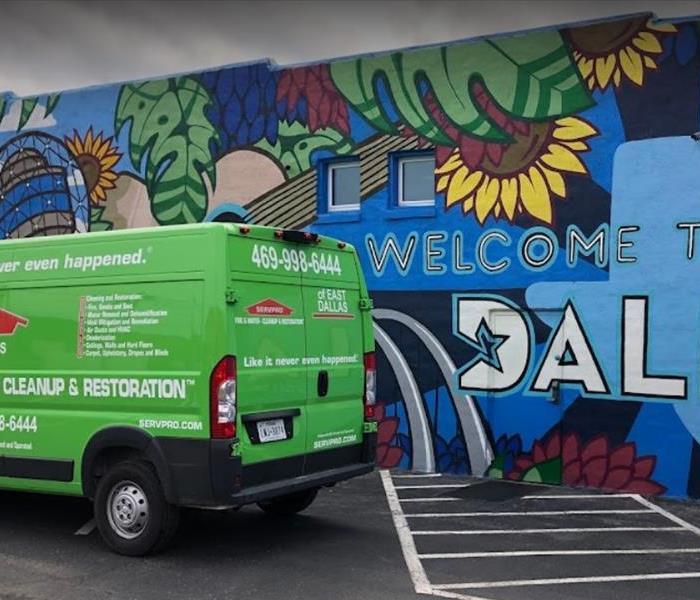 SERVPRO of East Dallas calls East Dallas home. We are here to help our local community.
SERVPRO of East Dallas calls East Dallas home. We are here to help our local community.
Hiring a water damage restoration company in East Dallas is crucial when dealing with water-related issues in your home or business. Here are some compelling reasons why you should consider hiring a professional water damage restoration company:
Quick response: Water damage requires immediate attention to prevent further damage and mold growth. A reputable water damage restoration company in East Dallas will respond promptly to your call and start the restoration process as quickly as possible.
Expertise and experience: Professional restoration companies have trained technicians with extensive experience in handling various types of water damage scenarios. They know the best techniques and equipment to effectively mitigate and repair the damage.
Advanced equipment: Water damage restoration requires specialized equipment, such as industrial-grade pumps, dehumidifiers, and air movers. These tools can efficiently remove water, dry the affected areas, and prevent secondary damage.
Thorough assessment: A reputable company will conduct a thorough assessment of the water damage, identifying all affected areas, even those not immediately visible. This ensures that no hidden issues are overlooked during the restoration process.
Mold prevention: Rapid water extraction and proper drying techniques are essential in preventing mold growth. Mold can start to grow within 24 to 48 hours after water damage occurs, so a professional restoration team can significantly reduce the risk of mold infestation.
Insurance assistance: Dealing with insurance companies can be complex after a water damage incident. A reliable restoration company can work directly with your insurance provider, documenting the damage and providing detailed reports to facilitate the claims process.
Health and safety: Water damage can expose you to health hazards, especially if the water is contaminated. Restoration professionals are equipped to handle hazardous materials safely, protecting you and your family from potential health risks.
Structural integrity: Water damage can compromise the structural integrity of your property. Hiring professionals ensures that the restoration process is carried out correctly, minimizing the risk of long-term structural issues.
Comprehensive restoration: Water damage restoration companies don't just address the visible damage; they provide comprehensive restoration services. This includes cleaning, sanitizing, deodorizing, and restoring your property to its pre-damage condition.
Peace of mind: Dealing with water damage can be stressful and overwhelming. Hiring a reputable water damage restoration company in East Dallas allows you to focus on other important aspects of your life or business while knowing that experts are handling the restoration process.
Overall, hiring a professional water damage restoration company in East Dallas is an investment in the proper and efficient recovery of your property. The quick response, expertise, and advanced equipment they provide will help minimize damage and ensure a safe and thorough restoration process.
Water Damage Causes & Fixes
7/24/2023 (Permalink)
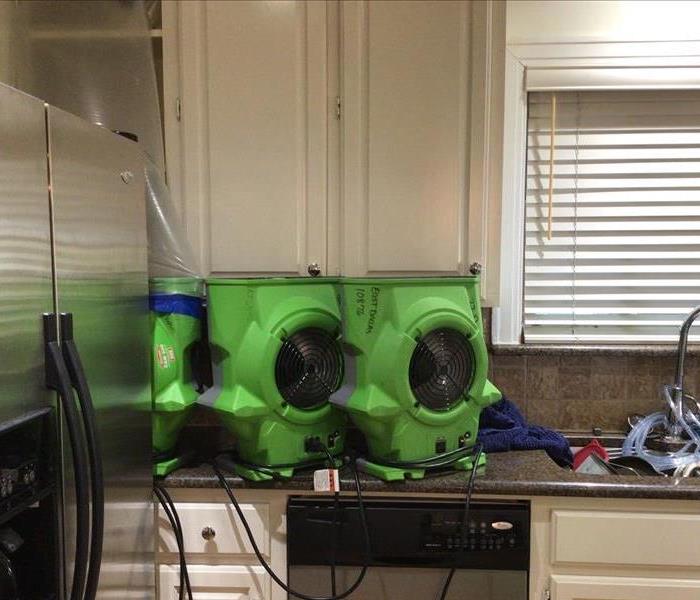 We were called out to clean and extract standing water in this Dallas home.
We were called out to clean and extract standing water in this Dallas home.
SERVPRO is here to talk about water damage and how it can be a serious problem for homes and buildings, leading to structural damage, mold growth, and other issues. We are able to recognized several common causes of water damage, and the appropriate fixes will depend on the extent of the damage and its source. Here are some common causes and potential fixes for water damage: SERVPRO of East Dallas is here to mention some of the main causes of water damage.
Causes of Water Damage:
Plumbing Leaks: Leaky pipes, faucets, or plumbing fixtures can lead to water damage over time, especially if left untreated.
Roof Leaks: Damaged or missing roof shingles, flashing, or vents can allow water to seep into the building, leading to water damage.
Flooding: Natural disasters like heavy rains, storms, hurricanes, or overflowing rivers can cause extensive water damage.
Appliance Malfunctions: Malfunctioning or leaking appliances, such as washing machines, dishwashers, and water heaters, can cause water damage in the surrounding areas.
Poor Drainage: Improperly designed or clogged gutters, downspouts, and improper grading around the building can lead to water pooling around the foundation, causing damage over time.
Burst Pipes: Freezing temperatures or excessive pressure can cause pipes to burst, releasing a significant amount of water into the building.
SERVPRO of East Dallas is here to also talk about some fixes of water damage.
Fixes for Water Damage:
Identify the Source: The first step in fixing water damage is to identify and stop the source of the water. If it's a plumbing leak, turn off the water supply to the affected area or the entire building if necessary.
Water Extraction: If there is standing water, it's crucial to remove it promptly to prevent further damage. Use pumps, wet-dry vacuums, or call a professional water restoration company for large-scale water removal.
Drying: Completely dry out the affected areas, including walls, floors, and furniture. Use dehumidifiers, fans, and open windows to facilitate the drying process.
Repair Leaks: Address the root cause of the water damage, whether it's a plumbing issue or a roof leak. Repair or replace the damaged components to prevent future water intrusion.
Mold Remediation: If water damage has resulted in mold growth, it's essential to have it professionally removed to prevent health risks and further damage.
Structural Repairs: Depending on the extent of the water damage, you may need to repair or replace damaged drywall, flooring, insulation, and other structural components.
Waterproofing: Consider applying waterproofing sealants to vulnerable areas like basements, crawl spaces, and exterior walls to prevent future water damage.
Improve Drainage: Ensure that gutters, downspouts, and grading around the building direct water away from the foundation to prevent water accumulation.
For extensive or severe water damage, it's best to seek help from professional water damage restoration companies. SERVPRO of East Dallas has the expertise to be able to handle any size disaster.
Deep Ellum's Trusted Water Heater Leak Repair Team
2/21/2023 (Permalink)
 We love to help our local community.
We love to help our local community.
Deep Ellum is a vibrant and growing neighborhood in Dallas, known for its trendy bars, music venues, and unique street art. However, like any other neighborhood, Deep Ellum is not immune to water damage caused by leaky water heaters. Water heater leaks can cause significant damage to homes and businesses, and it's important to know what to do in case of a water heater leak in Deep Ellum.
The first step when dealing with water damage caused by a water heater leak is to shut off the water supply to the water heater. This will prevent further water from leaking out and causing more damage. If you're unsure how to do this, consult the manual that came with your water heater or contact a plumber for assistance.
Next, it's important to assess the damage and determine if you need professional water damage restoration services. If the leak is minor and hasn't caused extensive damage, you may be able to clean up the water and dry out the affected area yourself. However, if the leak has caused significant damage, such as soaked carpets or damaged drywall, it's best to contact a professional restoration company to handle the cleanup and repair.
Water damage restoration companies have the necessary equipment and expertise to thoroughly clean and dry out the affected area, and to repair any damage that has been caused. They can also help with the insurance claims process and provide documentation to support your claim.
It's also important to take steps to prevent water heater leaks from occurring in the future. Regular maintenance of your water heater, including flushing the tank and inspecting the pipes and connections, can help prevent leaks from occurring. Additionally, installing a water alarm can alert you to leaks before they cause significant damage.
In conclusion, water heater leaks can cause significant damage to homes and businesses in Deep Ellum. If you experience a water heater leak, it's important to act quickly to shut off the water supply, assess the damage, and determine if professional water damage restoration services are needed. Taking steps to prevent water heater leaks from occurring in the future can also help protect your property from water damage.
How To Restore Your Home After A Flood
2/20/2023 (Permalink)
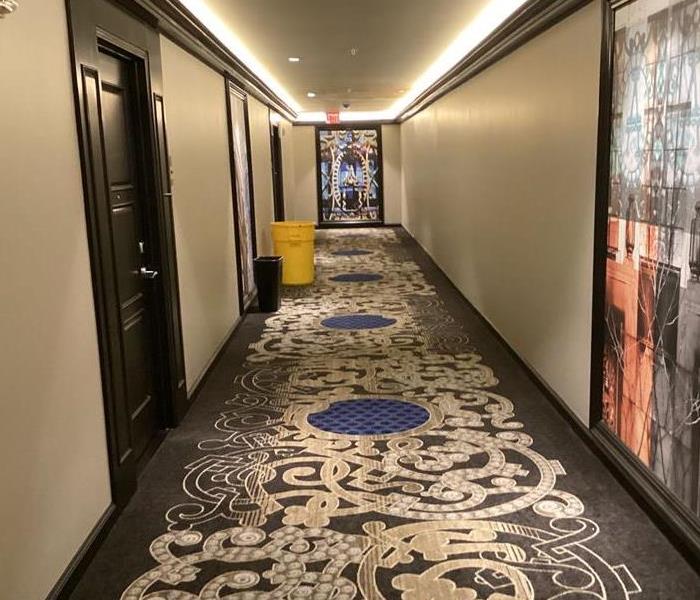 Local Hotel Suffers Water Damage Loss
Local Hotel Suffers Water Damage Loss
Water damage is a nightmare for any homeowner. Whether it's caused by a burst pipe, a leaking roof, or a natural disaster like a flood, water damage can cause serious problems for your home and your health. If you've experienced water damage, it's important to take action quickly to prevent further damage and restore your home to its preloss condition. In this blog, we'll discuss some tips and strategies for water damage repair that can help you get your home back on track.
Assess the Damage
The first step in water damage repair is to assess the damage. Take a careful look around your home and identify all areas that have been affected by water. Look for signs of water damage, such as water stains, mold growth, and dampness. If you're not sure where to start, consider hiring a professional water damage restoration company to perform an assessment.
Remove Standing Water
The next step is to remove any standing water from your home. If you have a significant amount of water in your home, you may need to use a pump to remove it. If the water damage is relatively minor, you may be able to use a wet/dry vacuum to suck up the water. Be sure to wear protective gear, such as gloves and boots, while doing this to avoid exposure to contaminated water.
Dry the Area
After you've removed the standing water, it's important to dry out the affected area as quickly as possible. Use fans and dehumidifiers to circulate air and remove moisture from the air. If you have access to natural sunlight, open windows and doors to allow fresh air in. This will help prevent mold growth and further damage to your home.
Clean and Disinfect
Once the affected area is dry, it's important to clean and disinfect it thoroughly. This will help prevent the growth of mold and bacteria, which can cause health problems for you and your family. Use a mixture of bleach and water to disinfect hard surfaces, such as floors and walls. Be sure to wear protective gear, such as gloves and a mask, while cleaning to avoid exposure to harmful chemicals.
Restore Your Home
Finally, it's time to restore your home to its preloss condition. This may involve replacing damaged materials, such as drywall and carpeting. Be sure to work with a reputable contractor who has experience in water damage restoration. They will be able to guide you through the restoration process and ensure that your home is safe and livable again.
Water damage can be a stressful and overwhelming experience for any homeowner. However, by taking action quickly and following these tips for water damage repair, you can restore your home and prevent further damage. Remember, the key is to act fast and work with a professional restoration company to ensure that your home is safe and healthy for you and your family.
The Importance of Prompt Water Damage Restoration in Dallas
2/6/2023 (Permalink)
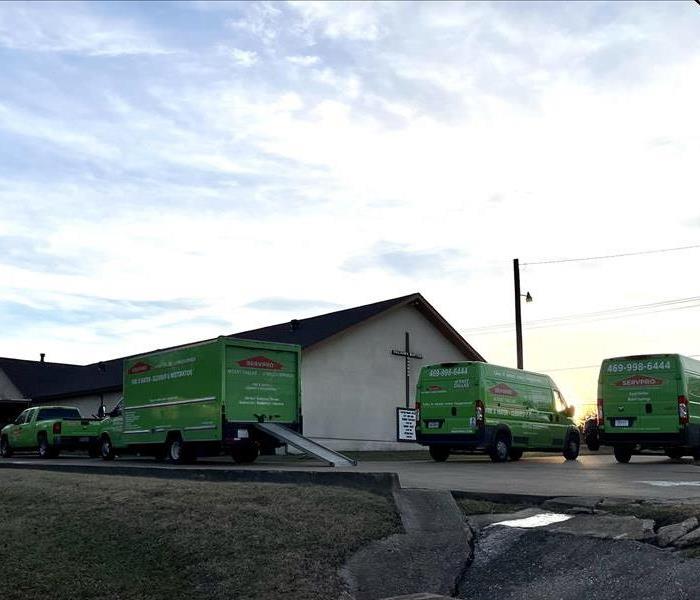 SERVPRO of East Dallas is not a stranger to water damage disasters. We are ready to help!
SERVPRO of East Dallas is not a stranger to water damage disasters. We are ready to help!
Water damage is a common problem in Dallas due to its humid and hot climate. However, prompt and effective water damage restoration is crucial to minimize the extent of damage and prevent the growth of mold and mildew. In this blog, we will discuss why prompt water damage restoration is important and what makes it different from regular cleaning services.
Time is of the essence: The longer water damage is left unattended, the more it will spread and cause structural damage to your property. Moreover, mold and mildew start growing within 24-48 hours of water damage, and the longer you wait, the more difficult and expensive it becomes to remove them.
Prevention of mold and mildew growth: Mold and mildew can cause severe health problems and allergies, so it's crucial to prevent their growth after water damage. Professional water damage restoration services use specialized equipment and techniques to quickly dry out the affected area, preventing mold and mildew growth.
Restoration of personal belongings: Water damage can cause irreparable damage to your personal belongings, including furniture, electronics, and clothing. Prompt water damage restoration services can save your valuable items by removing water, cleaning, and restoring them.
Protecting your insurance claim: If you have homeowner's insurance, you may be entitled to compensation for water damage. However, insurance companies may reject your claim if the damage was caused due to neglect or lack of prompt action. Hiring a professional water damage restoration company can help you protect your insurance claim and receive the compensation you deserve.
Water damage can cause significant damage to your property and personal belongings, but prompt and effective water damage restoration can minimize the extent of damage. Hiring a professional water damage restoration company in Dallas can save you time, money, and prevent potential health hazards. If you have suffered water damage, don't wait, call a water damage restoration expert today
Downtown Dallas Water and Fire Damage Restoration: Expert Services for Your Business.
2/6/2023 (Permalink)
Downtown Dallas is a vibrant area, home to a range of businesses and commercial properties. However, with the high volume of activity in the area, the risk of water and fire damage is a concern for many businesses. That's why it's essential to have access to expert water and fire damage restoration services when you need them. In this city page, we'll discuss why businesses in downtown Dallas need professional water and fire damage restoration services.
The dangers of water and fire damage: Water and fire incidents can cause significant damage to your business, disrupting your operations and causing financial losses. These incidents can also pose a threat to the health and safety of your employees and customers, making prompt and effective restoration essential.
The importance of professional services: Cleaning up water and fire damage is not a job for amateurs. It requires specialized equipment, techniques, and expertise to remove all traces of damage, including water damage, smoke damage, and soot damage. A professional water and fire damage restoration company in downtown Dallas can ensure that your business is restored quickly and efficiently.
Protecting your insurance claim: If you have commercial insurance, you may be entitled to compensation for water and fire damage. However, insurance companies may reject your claim if the damage was caused due to neglect or lack of prompt action. Hiring a professional water and fire damage restoration company in downtown Dallas can help you protect your insurance claim and receive the compensation you deserve.
Minimizing downtime: Water and fire incidents can cause a significant disruption to your business operations, resulting in lost revenue and downtime. A professional water and fire damage restoration company in downtown Dallas can help minimize downtime and get your business back up and running as quickly as possible.
Peace of mind: Dealing with water and fire damage can be overwhelming, and the thought of cleaning up the damage and restoring your business can be stressful. A professional water and fire damage restoration company in downtown Dallas can give you peace of mind, knowing that your business is in good hands and will be restored to its preloss condition as quickly as possible.
Water and fire incidents are a real concern for businesses in downtown Dallas. Prompt and effective water and fire damage restoration is essential to minimize the extent of damage and protect your business. A professional water and fire damage restoration company in downtown Dallas can provide the expertise and resources you need to restore your business quickly and efficiently. Don't wait, contact a water and fire damage restoration expert today.
East Dallas Suffers Freeze of the New Year
2/1/2023 (Permalink)
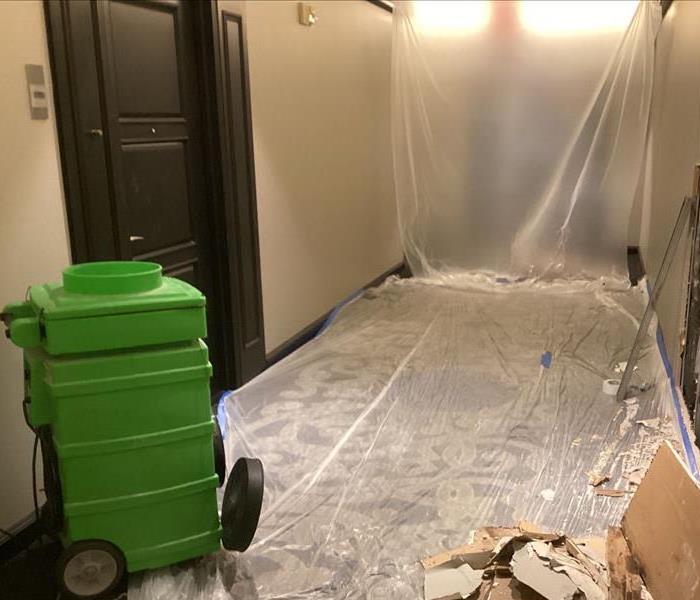 Here are some tips to staying warm during this freeze in Dallas.
Here are some tips to staying warm during this freeze in Dallas.
Here are some tips to staying warm during this freeze.
Keep garage doors closed, especially if there are water supply lines in the garage.
Open kitchen and bathroom cabinet doors to allow warmer air to circulate around the plumbing, especially if your sinks are on an exterior wall. (If you have small children, be sure to remove any harmful cleaners and household chemicals.)
Let the cold water drip from a faucet served by exposed pipes. Running water through the pipe—even at a trickle—helps prevent pipes from freezing.
Keep the thermostat set to the same temperature during day and night. Again, during a cold snap is not the time to set back the thermostat at night to save a few bucks on your heating bill.
If you plan to be away during cold weather, leave the heat on in your home, set to a temperature no lower than 55° F.
For the long term, add insulation to attics, basements, and crawl spaces. Insulation will maintain higher temperatures in those areas. And to prevent drafts, seal cracks and openings around windows, doors, and at sill plates, where the house rests on its foundation.






 24/7 Emergency Service
24/7 Emergency Service
